E-commerce and the Future of Retail
VerifiedAdded on 2020/05/16
|31
|8748
|365
AI Summary
This assignment delves into the transformative influence of e-commerce on the retail landscape. It examines emerging trends in Indian retailing, analyzes how supply chain strategies shape e-commerce success, and discusses the ethical implications of big data in market research. The assignment also touches upon the global expansion of businesses and the role of language in international business communication.
Contribute Materials
Your contribution can guide someone’s learning journey. Share your
documents today.
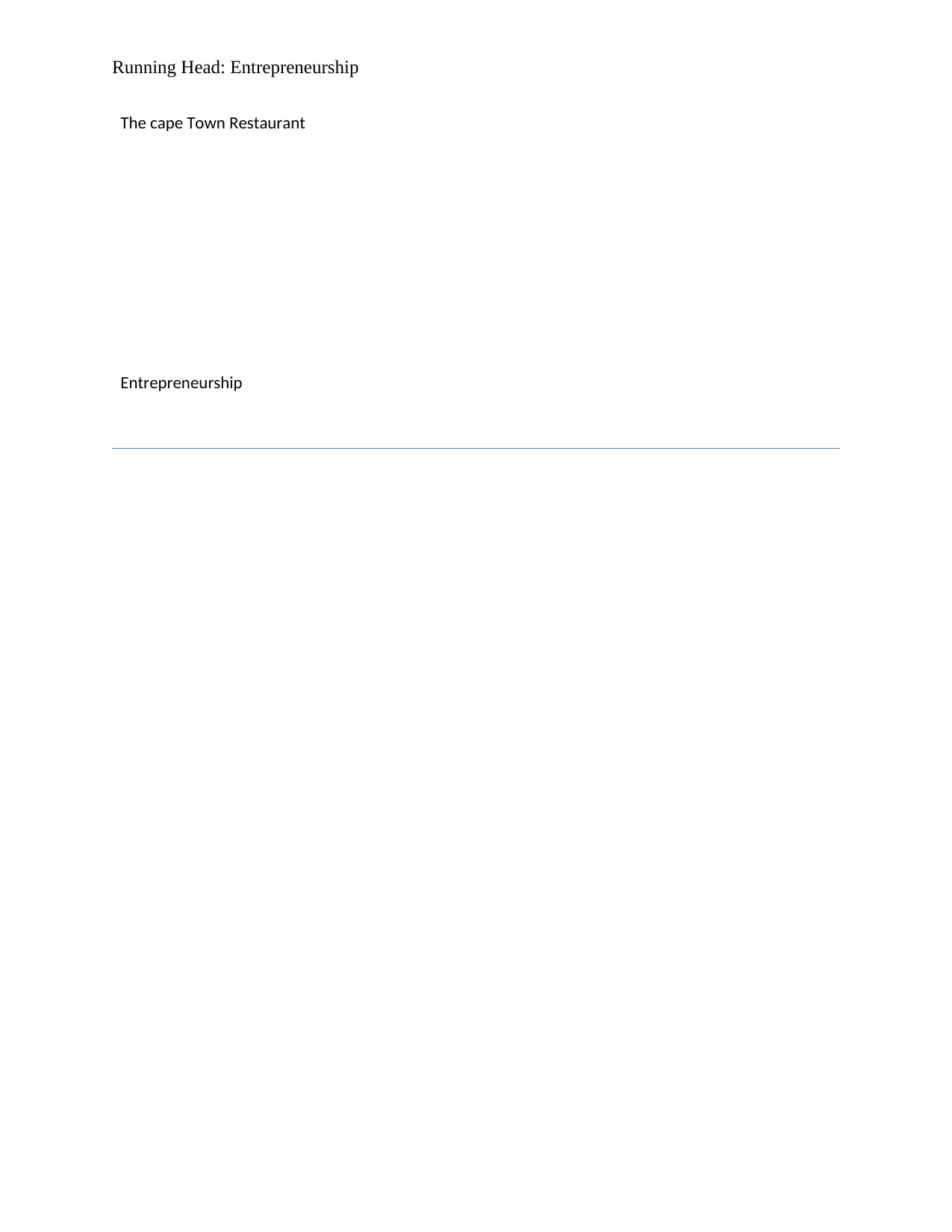
Running Head: Entrepreneurship
The cape Town Restaurant
Entrepreneurship
The cape Town Restaurant
Entrepreneurship
Secure Best Marks with AI Grader
Need help grading? Try our AI Grader for instant feedback on your assignments.
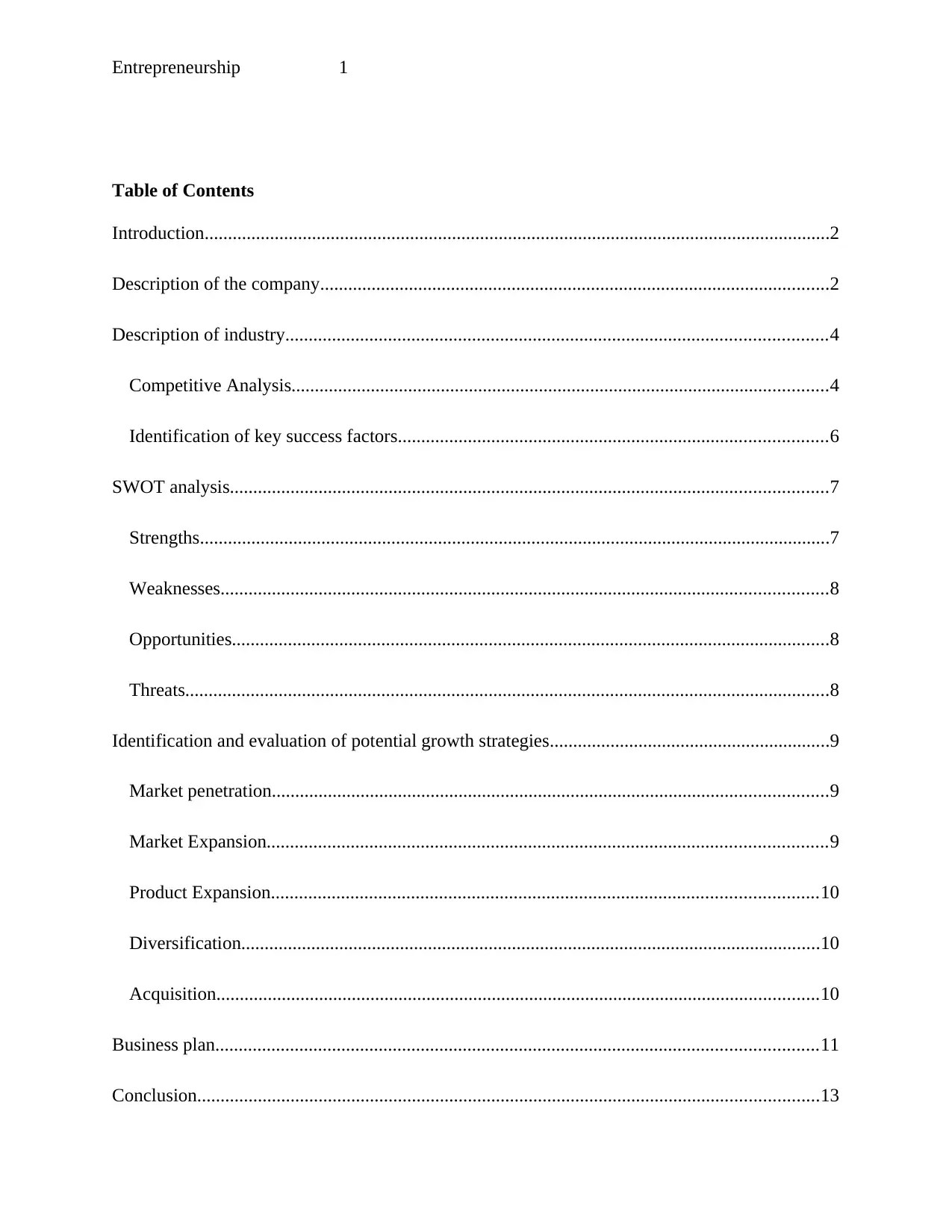
Entrepreneurship 1
Table of Contents
Introduction......................................................................................................................................2
Description of the company.............................................................................................................2
Description of industry....................................................................................................................4
Competitive Analysis...................................................................................................................4
Identification of key success factors............................................................................................6
SWOT analysis................................................................................................................................7
Strengths.......................................................................................................................................7
Weaknesses..................................................................................................................................8
Opportunities................................................................................................................................8
Threats..........................................................................................................................................8
Identification and evaluation of potential growth strategies............................................................9
Market penetration.......................................................................................................................9
Market Expansion........................................................................................................................9
Product Expansion.....................................................................................................................10
Diversification............................................................................................................................10
Acquisition.................................................................................................................................10
Business plan.................................................................................................................................11
Conclusion.....................................................................................................................................13
Table of Contents
Introduction......................................................................................................................................2
Description of the company.............................................................................................................2
Description of industry....................................................................................................................4
Competitive Analysis...................................................................................................................4
Identification of key success factors............................................................................................6
SWOT analysis................................................................................................................................7
Strengths.......................................................................................................................................7
Weaknesses..................................................................................................................................8
Opportunities................................................................................................................................8
Threats..........................................................................................................................................8
Identification and evaluation of potential growth strategies............................................................9
Market penetration.......................................................................................................................9
Market Expansion........................................................................................................................9
Product Expansion.....................................................................................................................10
Diversification............................................................................................................................10
Acquisition.................................................................................................................................10
Business plan.................................................................................................................................11
Conclusion.....................................................................................................................................13

Entrepreneurship 2
References......................................................................................................................................14
References......................................................................................................................................14

Entrepreneurship 3
Introduction
Entrepreneurship is a form of business entity. It is a process which is launched and developed for
executing a new business venture. Generally, entrepreneurship firm starts as a small venture and
later on it converts into big organizations. The person who operates the entrepreneurship firm is
known as the entrepreneur. This report will include various aspects of the strategic plan for the
new business enterprise i.e. The Cape Town Restaurant. For the same purpose, entrepreneur of
the restaurant has decided to develop a strategic cum business plan with the view to set up an
effective image in the target market. The business plan of the firm will include several sets of
strategies in order to attain the desired goals of the organization in an effective manner.
Major points which will be covered in this report are mission and vision of the organization
through which it their aims will be defined clearly. Further, SWOT analysis, competitive
analysis, KPIs and the like strategies will be discussed in this report. Organization and the
potential growth strategies will also be evaluated in this report in order to increase the
opportunities for the organization so that the motive of establishing the restaurant in Cape Town
could be acquired appropriately. The last phase of the report will include other aspects of the
business plan which will help the management and the entrepreneur of the restaurant to convert
their idea into reality.
Description of the company
The purpose of establishing The Cape Town Restaurant is for providing delicious and quality
dishes to the nationals of the target market. The specialty of this restaurant is that they serve
numerous food dishes which are famous across the globe. Their menu range includes Asian,
Introduction
Entrepreneurship is a form of business entity. It is a process which is launched and developed for
executing a new business venture. Generally, entrepreneurship firm starts as a small venture and
later on it converts into big organizations. The person who operates the entrepreneurship firm is
known as the entrepreneur. This report will include various aspects of the strategic plan for the
new business enterprise i.e. The Cape Town Restaurant. For the same purpose, entrepreneur of
the restaurant has decided to develop a strategic cum business plan with the view to set up an
effective image in the target market. The business plan of the firm will include several sets of
strategies in order to attain the desired goals of the organization in an effective manner.
Major points which will be covered in this report are mission and vision of the organization
through which it their aims will be defined clearly. Further, SWOT analysis, competitive
analysis, KPIs and the like strategies will be discussed in this report. Organization and the
potential growth strategies will also be evaluated in this report in order to increase the
opportunities for the organization so that the motive of establishing the restaurant in Cape Town
could be acquired appropriately. The last phase of the report will include other aspects of the
business plan which will help the management and the entrepreneur of the restaurant to convert
their idea into reality.
Description of the company
The purpose of establishing The Cape Town Restaurant is for providing delicious and quality
dishes to the nationals of the target market. The specialty of this restaurant is that they serve
numerous food dishes which are famous across the globe. Their menu range includes Asian,
Secure Best Marks with AI Grader
Need help grading? Try our AI Grader for instant feedback on your assignments.
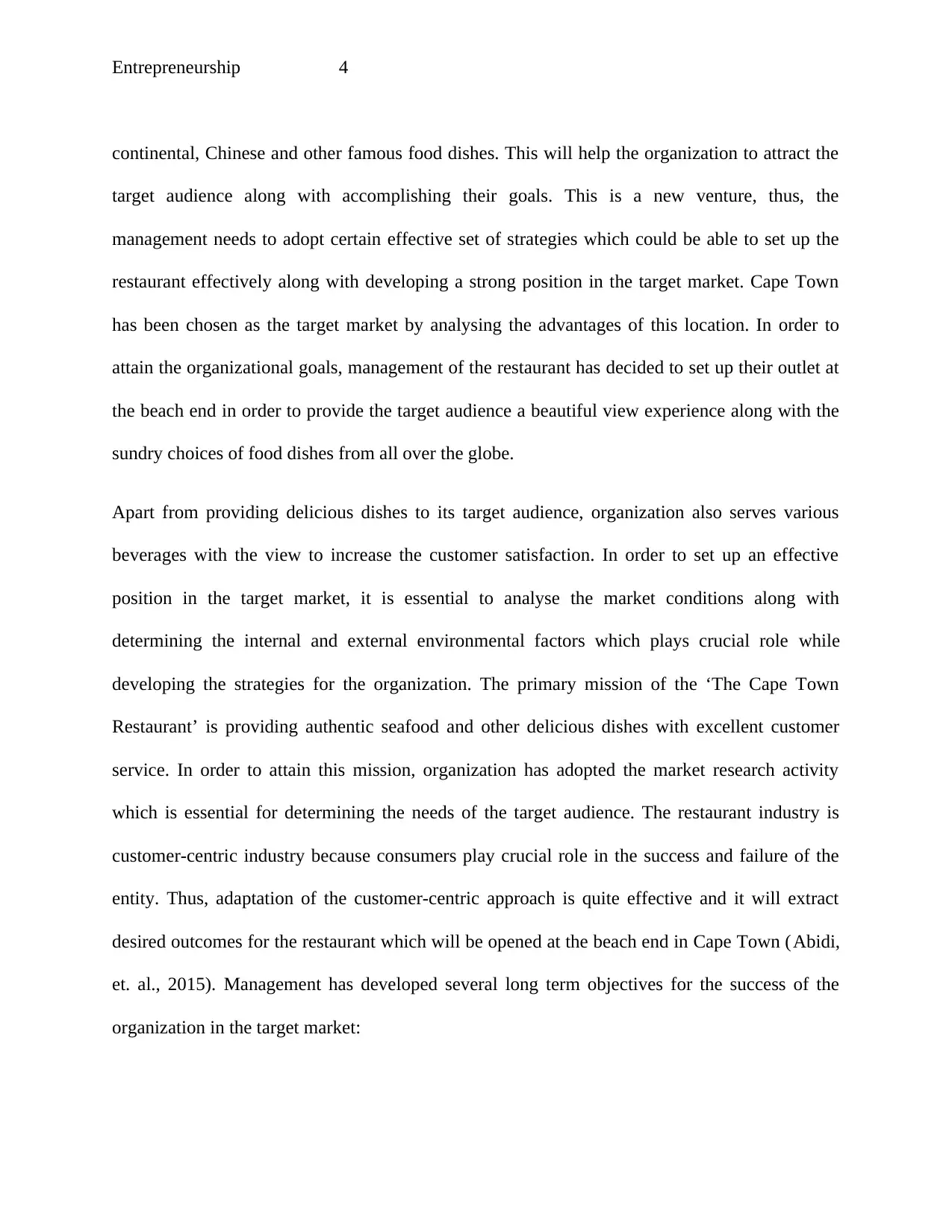
Entrepreneurship 4
continental, Chinese and other famous food dishes. This will help the organization to attract the
target audience along with accomplishing their goals. This is a new venture, thus, the
management needs to adopt certain effective set of strategies which could be able to set up the
restaurant effectively along with developing a strong position in the target market. Cape Town
has been chosen as the target market by analysing the advantages of this location. In order to
attain the organizational goals, management of the restaurant has decided to set up their outlet at
the beach end in order to provide the target audience a beautiful view experience along with the
sundry choices of food dishes from all over the globe.
Apart from providing delicious dishes to its target audience, organization also serves various
beverages with the view to increase the customer satisfaction. In order to set up an effective
position in the target market, it is essential to analyse the market conditions along with
determining the internal and external environmental factors which plays crucial role while
developing the strategies for the organization. The primary mission of the ‘The Cape Town
Restaurant’ is providing authentic seafood and other delicious dishes with excellent customer
service. In order to attain this mission, organization has adopted the market research activity
which is essential for determining the needs of the target audience. The restaurant industry is
customer-centric industry because consumers play crucial role in the success and failure of the
entity. Thus, adaptation of the customer-centric approach is quite effective and it will extract
desired outcomes for the restaurant which will be opened at the beach end in Cape Town (Abidi,
et. al., 2015). Management has developed several long term objectives for the success of the
organization in the target market:
continental, Chinese and other famous food dishes. This will help the organization to attract the
target audience along with accomplishing their goals. This is a new venture, thus, the
management needs to adopt certain effective set of strategies which could be able to set up the
restaurant effectively along with developing a strong position in the target market. Cape Town
has been chosen as the target market by analysing the advantages of this location. In order to
attain the organizational goals, management of the restaurant has decided to set up their outlet at
the beach end in order to provide the target audience a beautiful view experience along with the
sundry choices of food dishes from all over the globe.
Apart from providing delicious dishes to its target audience, organization also serves various
beverages with the view to increase the customer satisfaction. In order to set up an effective
position in the target market, it is essential to analyse the market conditions along with
determining the internal and external environmental factors which plays crucial role while
developing the strategies for the organization. The primary mission of the ‘The Cape Town
Restaurant’ is providing authentic seafood and other delicious dishes with excellent customer
service. In order to attain this mission, organization has adopted the market research activity
which is essential for determining the needs of the target audience. The restaurant industry is
customer-centric industry because consumers play crucial role in the success and failure of the
entity. Thus, adaptation of the customer-centric approach is quite effective and it will extract
desired outcomes for the restaurant which will be opened at the beach end in Cape Town (Abidi,
et. al., 2015). Management has developed several long term objectives for the success of the
organization in the target market:
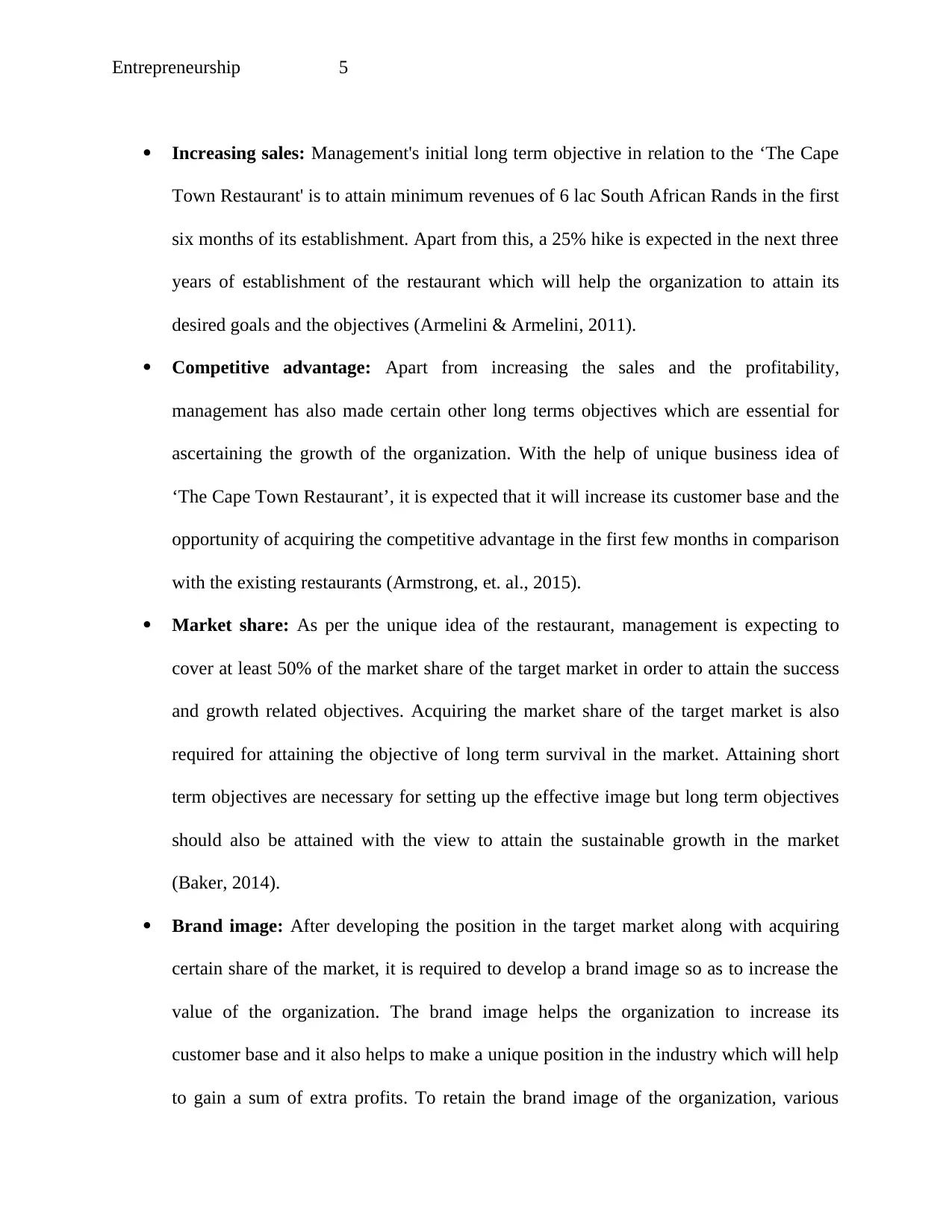
Entrepreneurship 5
Increasing sales: Management's initial long term objective in relation to the ‘The Cape
Town Restaurant' is to attain minimum revenues of 6 lac South African Rands in the first
six months of its establishment. Apart from this, a 25% hike is expected in the next three
years of establishment of the restaurant which will help the organization to attain its
desired goals and the objectives (Armelini & Armelini, 2011).
Competitive advantage: Apart from increasing the sales and the profitability,
management has also made certain other long terms objectives which are essential for
ascertaining the growth of the organization. With the help of unique business idea of
‘The Cape Town Restaurant’, it is expected that it will increase its customer base and the
opportunity of acquiring the competitive advantage in the first few months in comparison
with the existing restaurants (Armstrong, et. al., 2015).
Market share: As per the unique idea of the restaurant, management is expecting to
cover at least 50% of the market share of the target market in order to attain the success
and growth related objectives. Acquiring the market share of the target market is also
required for attaining the objective of long term survival in the market. Attaining short
term objectives are necessary for setting up the effective image but long term objectives
should also be attained with the view to attain the sustainable growth in the market
(Baker, 2014).
Brand image: After developing the position in the target market along with acquiring
certain share of the market, it is required to develop a brand image so as to increase the
value of the organization. The brand image helps the organization to increase its
customer base and it also helps to make a unique position in the industry which will help
to gain a sum of extra profits. To retain the brand image of the organization, various
Increasing sales: Management's initial long term objective in relation to the ‘The Cape
Town Restaurant' is to attain minimum revenues of 6 lac South African Rands in the first
six months of its establishment. Apart from this, a 25% hike is expected in the next three
years of establishment of the restaurant which will help the organization to attain its
desired goals and the objectives (Armelini & Armelini, 2011).
Competitive advantage: Apart from increasing the sales and the profitability,
management has also made certain other long terms objectives which are essential for
ascertaining the growth of the organization. With the help of unique business idea of
‘The Cape Town Restaurant’, it is expected that it will increase its customer base and the
opportunity of acquiring the competitive advantage in the first few months in comparison
with the existing restaurants (Armstrong, et. al., 2015).
Market share: As per the unique idea of the restaurant, management is expecting to
cover at least 50% of the market share of the target market in order to attain the success
and growth related objectives. Acquiring the market share of the target market is also
required for attaining the objective of long term survival in the market. Attaining short
term objectives are necessary for setting up the effective image but long term objectives
should also be attained with the view to attain the sustainable growth in the market
(Baker, 2014).
Brand image: After developing the position in the target market along with acquiring
certain share of the market, it is required to develop a brand image so as to increase the
value of the organization. The brand image helps the organization to increase its
customer base and it also helps to make a unique position in the industry which will help
to gain a sum of extra profits. To retain the brand image of the organization, various
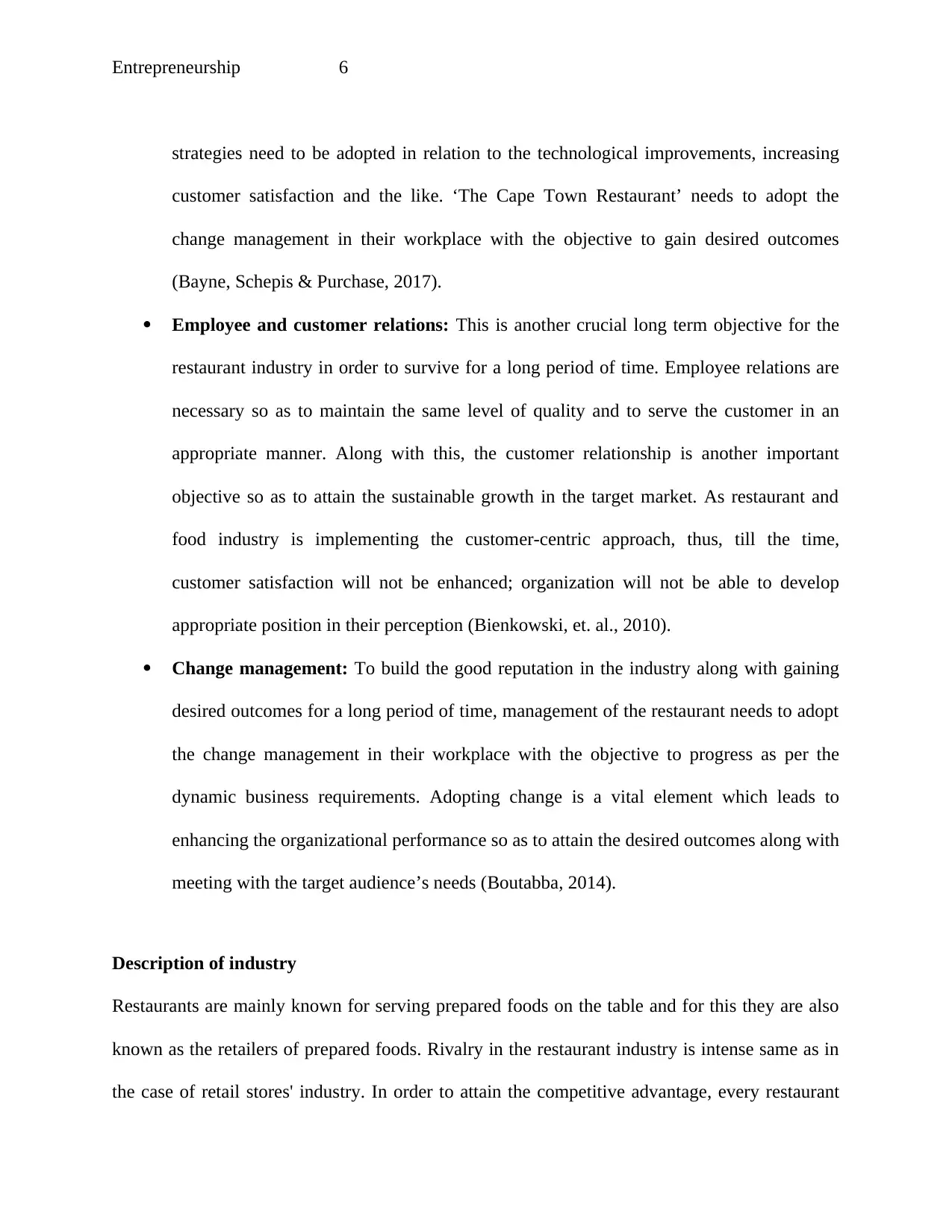
Entrepreneurship 6
strategies need to be adopted in relation to the technological improvements, increasing
customer satisfaction and the like. ‘The Cape Town Restaurant’ needs to adopt the
change management in their workplace with the objective to gain desired outcomes
(Bayne, Schepis & Purchase, 2017).
Employee and customer relations: This is another crucial long term objective for the
restaurant industry in order to survive for a long period of time. Employee relations are
necessary so as to maintain the same level of quality and to serve the customer in an
appropriate manner. Along with this, the customer relationship is another important
objective so as to attain the sustainable growth in the target market. As restaurant and
food industry is implementing the customer-centric approach, thus, till the time,
customer satisfaction will not be enhanced; organization will not be able to develop
appropriate position in their perception (Bienkowski, et. al., 2010).
Change management: To build the good reputation in the industry along with gaining
desired outcomes for a long period of time, management of the restaurant needs to adopt
the change management in their workplace with the objective to progress as per the
dynamic business requirements. Adopting change is a vital element which leads to
enhancing the organizational performance so as to attain the desired outcomes along with
meeting with the target audience’s needs (Boutabba, 2014).
Description of industry
Restaurants are mainly known for serving prepared foods on the table and for this they are also
known as the retailers of prepared foods. Rivalry in the restaurant industry is intense same as in
the case of retail stores' industry. In order to attain the competitive advantage, every restaurant
strategies need to be adopted in relation to the technological improvements, increasing
customer satisfaction and the like. ‘The Cape Town Restaurant’ needs to adopt the
change management in their workplace with the objective to gain desired outcomes
(Bayne, Schepis & Purchase, 2017).
Employee and customer relations: This is another crucial long term objective for the
restaurant industry in order to survive for a long period of time. Employee relations are
necessary so as to maintain the same level of quality and to serve the customer in an
appropriate manner. Along with this, the customer relationship is another important
objective so as to attain the sustainable growth in the target market. As restaurant and
food industry is implementing the customer-centric approach, thus, till the time,
customer satisfaction will not be enhanced; organization will not be able to develop
appropriate position in their perception (Bienkowski, et. al., 2010).
Change management: To build the good reputation in the industry along with gaining
desired outcomes for a long period of time, management of the restaurant needs to adopt
the change management in their workplace with the objective to progress as per the
dynamic business requirements. Adopting change is a vital element which leads to
enhancing the organizational performance so as to attain the desired outcomes along with
meeting with the target audience’s needs (Boutabba, 2014).
Description of industry
Restaurants are mainly known for serving prepared foods on the table and for this they are also
known as the retailers of prepared foods. Rivalry in the restaurant industry is intense same as in
the case of retail stores' industry. In order to attain the competitive advantage, every restaurant
Paraphrase This Document
Need a fresh take? Get an instant paraphrase of this document with our AI Paraphraser

Entrepreneurship 7
modifies its range of menu along with determining the factors involved in the external business
environment so that appropriate strategies could be developed to match up with those
requirements. There are numerous factors which influence the competition amongst the
restaurant companies. These factors are interior designating, location of the restaurant, food
served, quality of the food, range of menu offered by them and the most important is the price
charged by the restraints against their services. The Cape Town Restaurant has included all these
factors in order to make a separate position in the restaurant industry of Cape Town (Bryman &
Bell, 2015). With its unique idea of serving delicious dishes along with excellent customer
service and with the exotic location of their outlet, organization will easily be able to mark a
distinctive marketplace in the industry. Apart from this, there are sundry factors which affect the
organizational performance such competition, external marketing conditions and the like (Wu &
Chen, 2014).
Competitive Analysis
It is a critical part which evaluates the strategies used by the competitors to produce the products
and services. With the help of this evaluation, an organization could easily develop more
effective and dynamic strategies through which competitive advantage could be attained along
with differentiating their products and services with the competitors’. In the competitive analysis,
primary competitors are being evaluated for the organization and their strengths and weaknesses
are measured to estimate their position in the industry. Along with the strengths and weaknesses
of the competitors, opportunities and threats are also identified with the help of this analysis.
Outcomes originated form this evaluation; organization would be able to design their strategies
modifies its range of menu along with determining the factors involved in the external business
environment so that appropriate strategies could be developed to match up with those
requirements. There are numerous factors which influence the competition amongst the
restaurant companies. These factors are interior designating, location of the restaurant, food
served, quality of the food, range of menu offered by them and the most important is the price
charged by the restraints against their services. The Cape Town Restaurant has included all these
factors in order to make a separate position in the restaurant industry of Cape Town (Bryman &
Bell, 2015). With its unique idea of serving delicious dishes along with excellent customer
service and with the exotic location of their outlet, organization will easily be able to mark a
distinctive marketplace in the industry. Apart from this, there are sundry factors which affect the
organizational performance such competition, external marketing conditions and the like (Wu &
Chen, 2014).
Competitive Analysis
It is a critical part which evaluates the strategies used by the competitors to produce the products
and services. With the help of this evaluation, an organization could easily develop more
effective and dynamic strategies through which competitive advantage could be attained along
with differentiating their products and services with the competitors’. In the competitive analysis,
primary competitors are being evaluated for the organization and their strengths and weaknesses
are measured to estimate their position in the industry. Along with the strengths and weaknesses
of the competitors, opportunities and threats are also identified with the help of this analysis.
Outcomes originated form this evaluation; organization would be able to design their strategies
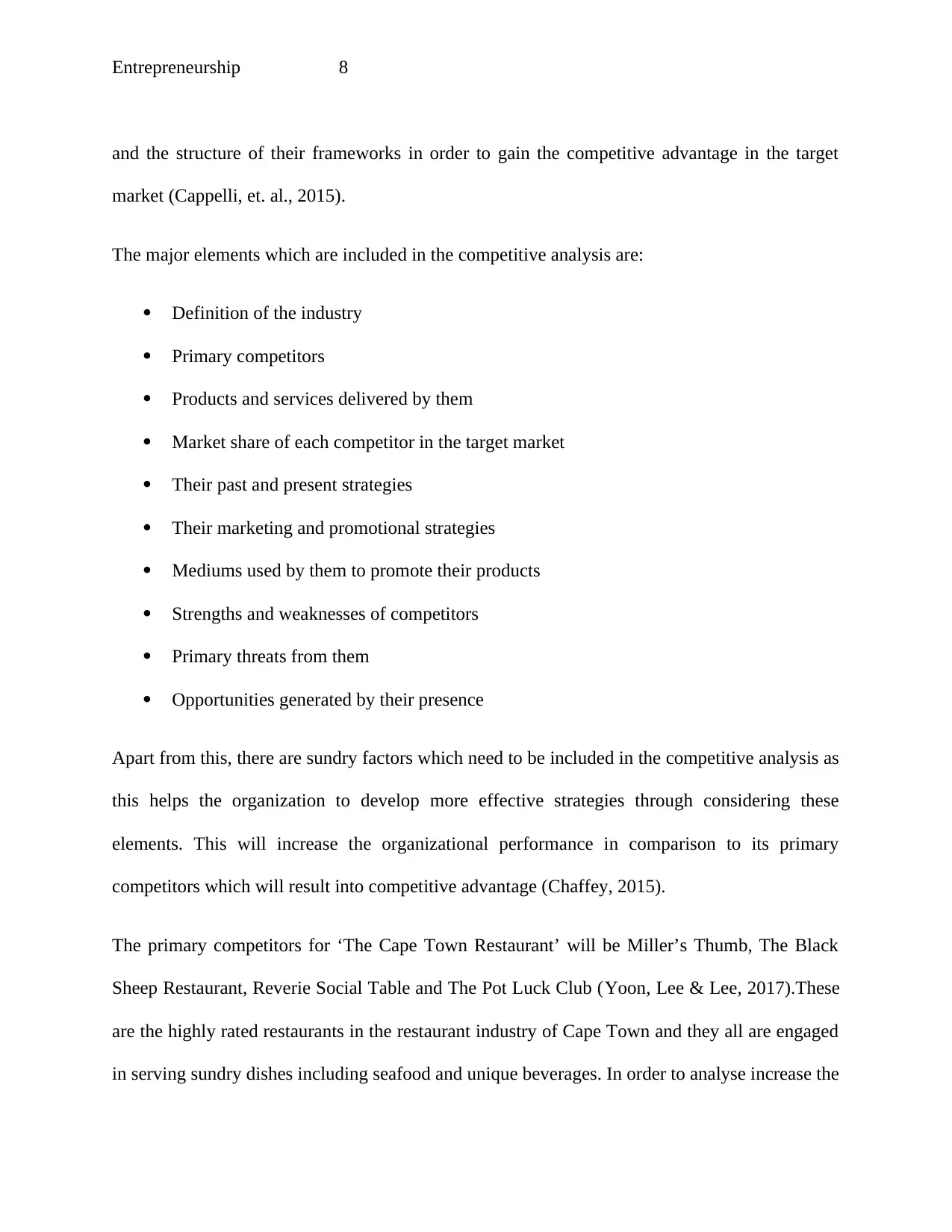
Entrepreneurship 8
and the structure of their frameworks in order to gain the competitive advantage in the target
market (Cappelli, et. al., 2015).
The major elements which are included in the competitive analysis are:
Definition of the industry
Primary competitors
Products and services delivered by them
Market share of each competitor in the target market
Their past and present strategies
Their marketing and promotional strategies
Mediums used by them to promote their products
Strengths and weaknesses of competitors
Primary threats from them
Opportunities generated by their presence
Apart from this, there are sundry factors which need to be included in the competitive analysis as
this helps the organization to develop more effective strategies through considering these
elements. This will increase the organizational performance in comparison to its primary
competitors which will result into competitive advantage (Chaffey, 2015).
The primary competitors for ‘The Cape Town Restaurant’ will be Miller’s Thumb, The Black
Sheep Restaurant, Reverie Social Table and The Pot Luck Club (Yoon, Lee & Lee, 2017).These
are the highly rated restaurants in the restaurant industry of Cape Town and they all are engaged
in serving sundry dishes including seafood and unique beverages. In order to analyse increase the
and the structure of their frameworks in order to gain the competitive advantage in the target
market (Cappelli, et. al., 2015).
The major elements which are included in the competitive analysis are:
Definition of the industry
Primary competitors
Products and services delivered by them
Market share of each competitor in the target market
Their past and present strategies
Their marketing and promotional strategies
Mediums used by them to promote their products
Strengths and weaknesses of competitors
Primary threats from them
Opportunities generated by their presence
Apart from this, there are sundry factors which need to be included in the competitive analysis as
this helps the organization to develop more effective strategies through considering these
elements. This will increase the organizational performance in comparison to its primary
competitors which will result into competitive advantage (Chaffey, 2015).
The primary competitors for ‘The Cape Town Restaurant’ will be Miller’s Thumb, The Black
Sheep Restaurant, Reverie Social Table and The Pot Luck Club (Yoon, Lee & Lee, 2017).These
are the highly rated restaurants in the restaurant industry of Cape Town and they all are engaged
in serving sundry dishes including seafood and unique beverages. In order to analyse increase the

Entrepreneurship 9
value of the ‘The Cape Town Restaurant’, it is required to conduct the competitive analysis along
with the above mentioned factors.
Reverie Social Table is a vegetarian restaurant mainly known for providing social dining. Chef
Patron Julia Hattingh welcomes the guests every evening to seat on the 18-seater table and enjoy
five-course meal exclusively at their place along with selected wines. Their specialty is that
guests are asked to put their phones away or in the non-disturbance mode so that they could
interact with each other. It is a major attraction of the restaurant and their major target audience
are people who love to enjoy food with wine and with a great company. Apart from these
services and attraction, this restaurant is rated on the sixth position amongst 928 restaurants in
Cape Town Central (Reverie Social Table, 2018).
The Pot Luck Club is a roof top restaurant and it was established in 2013 and in a short period of
time, this is being rated on the 7th position amongst the 928 restaurants in Cape Town Central.
This place is famous for its unique cuisine and it is also rated as the coolest place to hang out
with relatives, friends, and loved ones. Irrespective of the peak and lean season, this restaurant is
full pack and it has a seating capacity of approximately 120 guests at a time (The Pot Luck Club,
2018).
Miller’s Thumb is another best restaurant in Cape Town, it was established in 1995 just off the
main thoroughfare between the Cape Town Waterfront and the aerial cable way. The ambience
provided by the restaurant is unique along with the qualitative and delicious food dishes. This is
majorly known for delivering seafood and amongst them; the fish dish is their specialty. This
restaurant stands on the 4th position in the best restaurant category in Cape Town Central
(Miller’s Thumb, 2018).
value of the ‘The Cape Town Restaurant’, it is required to conduct the competitive analysis along
with the above mentioned factors.
Reverie Social Table is a vegetarian restaurant mainly known for providing social dining. Chef
Patron Julia Hattingh welcomes the guests every evening to seat on the 18-seater table and enjoy
five-course meal exclusively at their place along with selected wines. Their specialty is that
guests are asked to put their phones away or in the non-disturbance mode so that they could
interact with each other. It is a major attraction of the restaurant and their major target audience
are people who love to enjoy food with wine and with a great company. Apart from these
services and attraction, this restaurant is rated on the sixth position amongst 928 restaurants in
Cape Town Central (Reverie Social Table, 2018).
The Pot Luck Club is a roof top restaurant and it was established in 2013 and in a short period of
time, this is being rated on the 7th position amongst the 928 restaurants in Cape Town Central.
This place is famous for its unique cuisine and it is also rated as the coolest place to hang out
with relatives, friends, and loved ones. Irrespective of the peak and lean season, this restaurant is
full pack and it has a seating capacity of approximately 120 guests at a time (The Pot Luck Club,
2018).
Miller’s Thumb is another best restaurant in Cape Town, it was established in 1995 just off the
main thoroughfare between the Cape Town Waterfront and the aerial cable way. The ambience
provided by the restaurant is unique along with the qualitative and delicious food dishes. This is
majorly known for delivering seafood and amongst them; the fish dish is their specialty. This
restaurant stands on the 4th position in the best restaurant category in Cape Town Central
(Miller’s Thumb, 2018).
Secure Best Marks with AI Grader
Need help grading? Try our AI Grader for instant feedback on your assignments.

Entrepreneurship 10
The Black Sheep Restaurant is running since 20 years in the UK and South Africa. This stands
on the 8th position in the top rated restaurants in the Cape Town Central. Irrespective of the
seasons, menu range of the restaurant serves fix dishes on daily basis following the tradition of
The Black Sheep is always about making merry, with the best quality food and best service. No
one leaves The Black Sheep hungry (The Black Sheep Restaurant, 2018).
Reviewing all these strengths and weaknesses of these competitors, ‘The Cape Town Restaurant'
could be able to mold their strategies in such a way so that competitive advantage could be
attained easily. With the help of these strategies, organization will be able to develop a distinct
position in the target market along with its unique business idea of opening the outlet at the
beach end. This will help the organization to attain its desired goals. The strategies which could
be adopted for attaining the competitive advantage are cost leadership, product differentiation
approach, and the like. These are two approaches which help the organization to increase its
effectiveness in the target market along with setting up a competitive place in comparison to the
existing restaurant companies (Chang, 2016).
Cost leadership approach describes a reduction of unnecessary costs in order to set the affordable
prices for the finished goods. Restaurant companies which are known for serving prepared food
could also adopt this strategy with the objective to lower down the prices of the dishes served
within the restaurant for a certain period of time, mainly for the initial period from setting up the
outlet. This approach will help the organization to attract large number of customers irrespective
of their segments (Yu, et. al., 2016). With the large customer base, an organization would be able
to accomplish its short term objectives of reaching the desired mark of sales and revenues with a
certain margin of profitability. Along with this, cost leadership approach also leads to the
The Black Sheep Restaurant is running since 20 years in the UK and South Africa. This stands
on the 8th position in the top rated restaurants in the Cape Town Central. Irrespective of the
seasons, menu range of the restaurant serves fix dishes on daily basis following the tradition of
The Black Sheep is always about making merry, with the best quality food and best service. No
one leaves The Black Sheep hungry (The Black Sheep Restaurant, 2018).
Reviewing all these strengths and weaknesses of these competitors, ‘The Cape Town Restaurant'
could be able to mold their strategies in such a way so that competitive advantage could be
attained easily. With the help of these strategies, organization will be able to develop a distinct
position in the target market along with its unique business idea of opening the outlet at the
beach end. This will help the organization to attain its desired goals. The strategies which could
be adopted for attaining the competitive advantage are cost leadership, product differentiation
approach, and the like. These are two approaches which help the organization to increase its
effectiveness in the target market along with setting up a competitive place in comparison to the
existing restaurant companies (Chang, 2016).
Cost leadership approach describes a reduction of unnecessary costs in order to set the affordable
prices for the finished goods. Restaurant companies which are known for serving prepared food
could also adopt this strategy with the objective to lower down the prices of the dishes served
within the restaurant for a certain period of time, mainly for the initial period from setting up the
outlet. This approach will help the organization to attract large number of customers irrespective
of their segments (Yu, et. al., 2016). With the large customer base, an organization would be able
to accomplish its short term objectives of reaching the desired mark of sales and revenues with a
certain margin of profitability. Along with this, cost leadership approach also leads to the
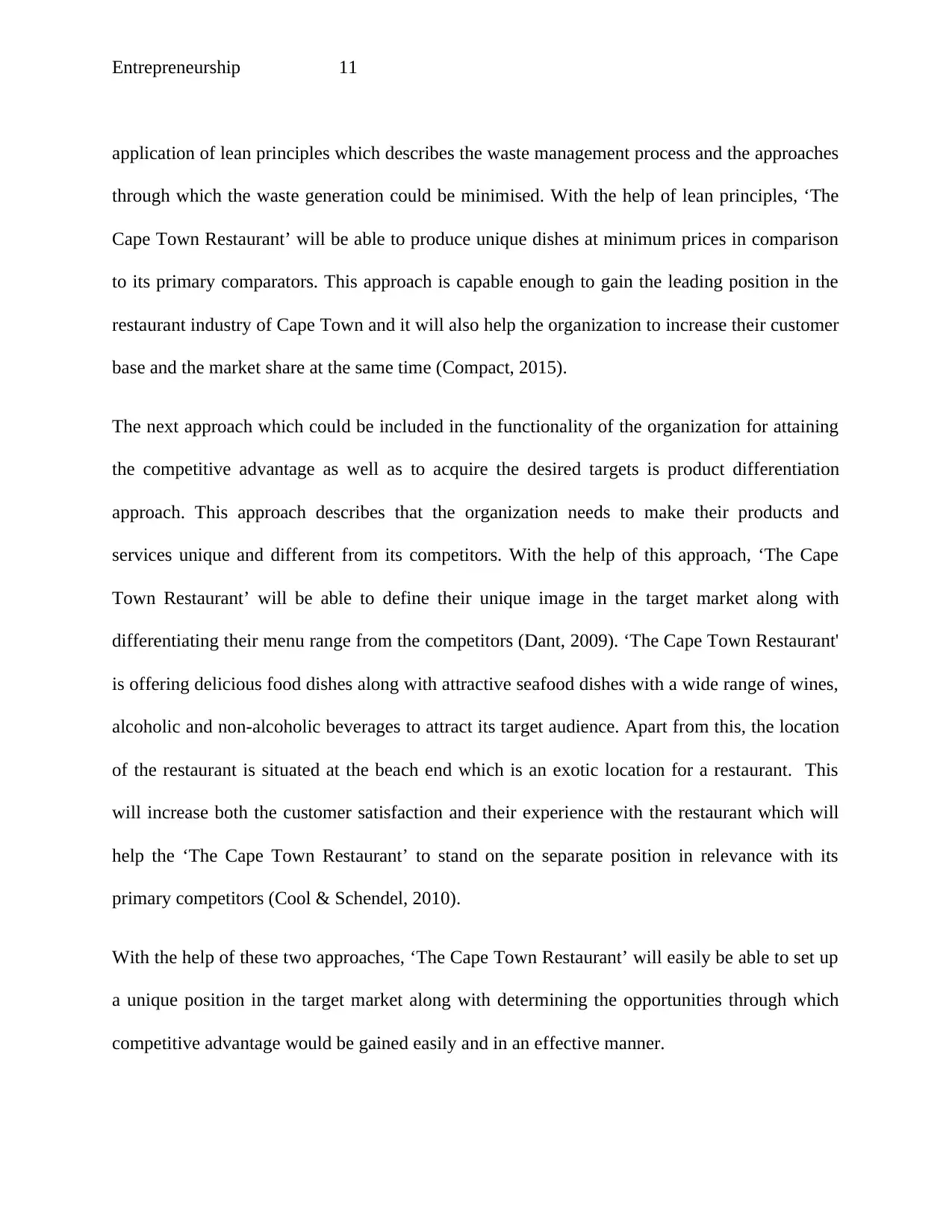
Entrepreneurship 11
application of lean principles which describes the waste management process and the approaches
through which the waste generation could be minimised. With the help of lean principles, ‘The
Cape Town Restaurant’ will be able to produce unique dishes at minimum prices in comparison
to its primary comparators. This approach is capable enough to gain the leading position in the
restaurant industry of Cape Town and it will also help the organization to increase their customer
base and the market share at the same time (Compact, 2015).
The next approach which could be included in the functionality of the organization for attaining
the competitive advantage as well as to acquire the desired targets is product differentiation
approach. This approach describes that the organization needs to make their products and
services unique and different from its competitors. With the help of this approach, ‘The Cape
Town Restaurant’ will be able to define their unique image in the target market along with
differentiating their menu range from the competitors (Dant, 2009). ‘The Cape Town Restaurant'
is offering delicious food dishes along with attractive seafood dishes with a wide range of wines,
alcoholic and non-alcoholic beverages to attract its target audience. Apart from this, the location
of the restaurant is situated at the beach end which is an exotic location for a restaurant. This
will increase both the customer satisfaction and their experience with the restaurant which will
help the ‘The Cape Town Restaurant’ to stand on the separate position in relevance with its
primary competitors (Cool & Schendel, 2010).
With the help of these two approaches, ‘The Cape Town Restaurant’ will easily be able to set up
a unique position in the target market along with determining the opportunities through which
competitive advantage would be gained easily and in an effective manner.
application of lean principles which describes the waste management process and the approaches
through which the waste generation could be minimised. With the help of lean principles, ‘The
Cape Town Restaurant’ will be able to produce unique dishes at minimum prices in comparison
to its primary comparators. This approach is capable enough to gain the leading position in the
restaurant industry of Cape Town and it will also help the organization to increase their customer
base and the market share at the same time (Compact, 2015).
The next approach which could be included in the functionality of the organization for attaining
the competitive advantage as well as to acquire the desired targets is product differentiation
approach. This approach describes that the organization needs to make their products and
services unique and different from its competitors. With the help of this approach, ‘The Cape
Town Restaurant’ will be able to define their unique image in the target market along with
differentiating their menu range from the competitors (Dant, 2009). ‘The Cape Town Restaurant'
is offering delicious food dishes along with attractive seafood dishes with a wide range of wines,
alcoholic and non-alcoholic beverages to attract its target audience. Apart from this, the location
of the restaurant is situated at the beach end which is an exotic location for a restaurant. This
will increase both the customer satisfaction and their experience with the restaurant which will
help the ‘The Cape Town Restaurant’ to stand on the separate position in relevance with its
primary competitors (Cool & Schendel, 2010).
With the help of these two approaches, ‘The Cape Town Restaurant’ will easily be able to set up
a unique position in the target market along with determining the opportunities through which
competitive advantage would be gained easily and in an effective manner.
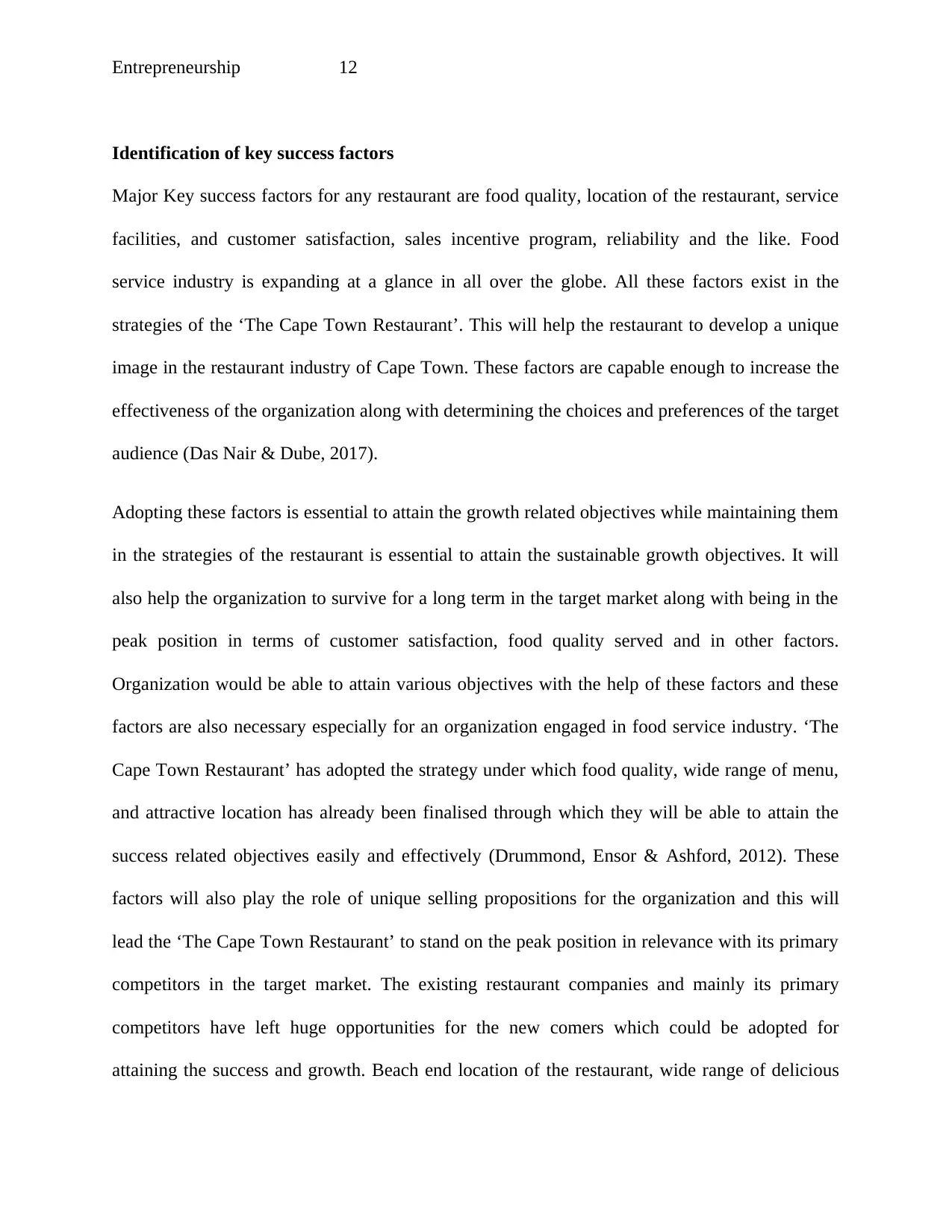
Entrepreneurship 12
Identification of key success factors
Major Key success factors for any restaurant are food quality, location of the restaurant, service
facilities, and customer satisfaction, sales incentive program, reliability and the like. Food
service industry is expanding at a glance in all over the globe. All these factors exist in the
strategies of the ‘The Cape Town Restaurant’. This will help the restaurant to develop a unique
image in the restaurant industry of Cape Town. These factors are capable enough to increase the
effectiveness of the organization along with determining the choices and preferences of the target
audience (Das Nair & Dube, 2017).
Adopting these factors is essential to attain the growth related objectives while maintaining them
in the strategies of the restaurant is essential to attain the sustainable growth objectives. It will
also help the organization to survive for a long term in the target market along with being in the
peak position in terms of customer satisfaction, food quality served and in other factors.
Organization would be able to attain various objectives with the help of these factors and these
factors are also necessary especially for an organization engaged in food service industry. ‘The
Cape Town Restaurant’ has adopted the strategy under which food quality, wide range of menu,
and attractive location has already been finalised through which they will be able to attain the
success related objectives easily and effectively (Drummond, Ensor & Ashford, 2012). These
factors will also play the role of unique selling propositions for the organization and this will
lead the ‘The Cape Town Restaurant’ to stand on the peak position in relevance with its primary
competitors in the target market. The existing restaurant companies and mainly its primary
competitors have left huge opportunities for the new comers which could be adopted for
attaining the success and growth. Beach end location of the restaurant, wide range of delicious
Identification of key success factors
Major Key success factors for any restaurant are food quality, location of the restaurant, service
facilities, and customer satisfaction, sales incentive program, reliability and the like. Food
service industry is expanding at a glance in all over the globe. All these factors exist in the
strategies of the ‘The Cape Town Restaurant’. This will help the restaurant to develop a unique
image in the restaurant industry of Cape Town. These factors are capable enough to increase the
effectiveness of the organization along with determining the choices and preferences of the target
audience (Das Nair & Dube, 2017).
Adopting these factors is essential to attain the growth related objectives while maintaining them
in the strategies of the restaurant is essential to attain the sustainable growth objectives. It will
also help the organization to survive for a long term in the target market along with being in the
peak position in terms of customer satisfaction, food quality served and in other factors.
Organization would be able to attain various objectives with the help of these factors and these
factors are also necessary especially for an organization engaged in food service industry. ‘The
Cape Town Restaurant’ has adopted the strategy under which food quality, wide range of menu,
and attractive location has already been finalised through which they will be able to attain the
success related objectives easily and effectively (Drummond, Ensor & Ashford, 2012). These
factors will also play the role of unique selling propositions for the organization and this will
lead the ‘The Cape Town Restaurant’ to stand on the peak position in relevance with its primary
competitors in the target market. The existing restaurant companies and mainly its primary
competitors have left huge opportunities for the new comers which could be adopted for
attaining the success and growth. Beach end location of the restaurant, wide range of delicious
Paraphrase This Document
Need a fresh take? Get an instant paraphrase of this document with our AI Paraphraser
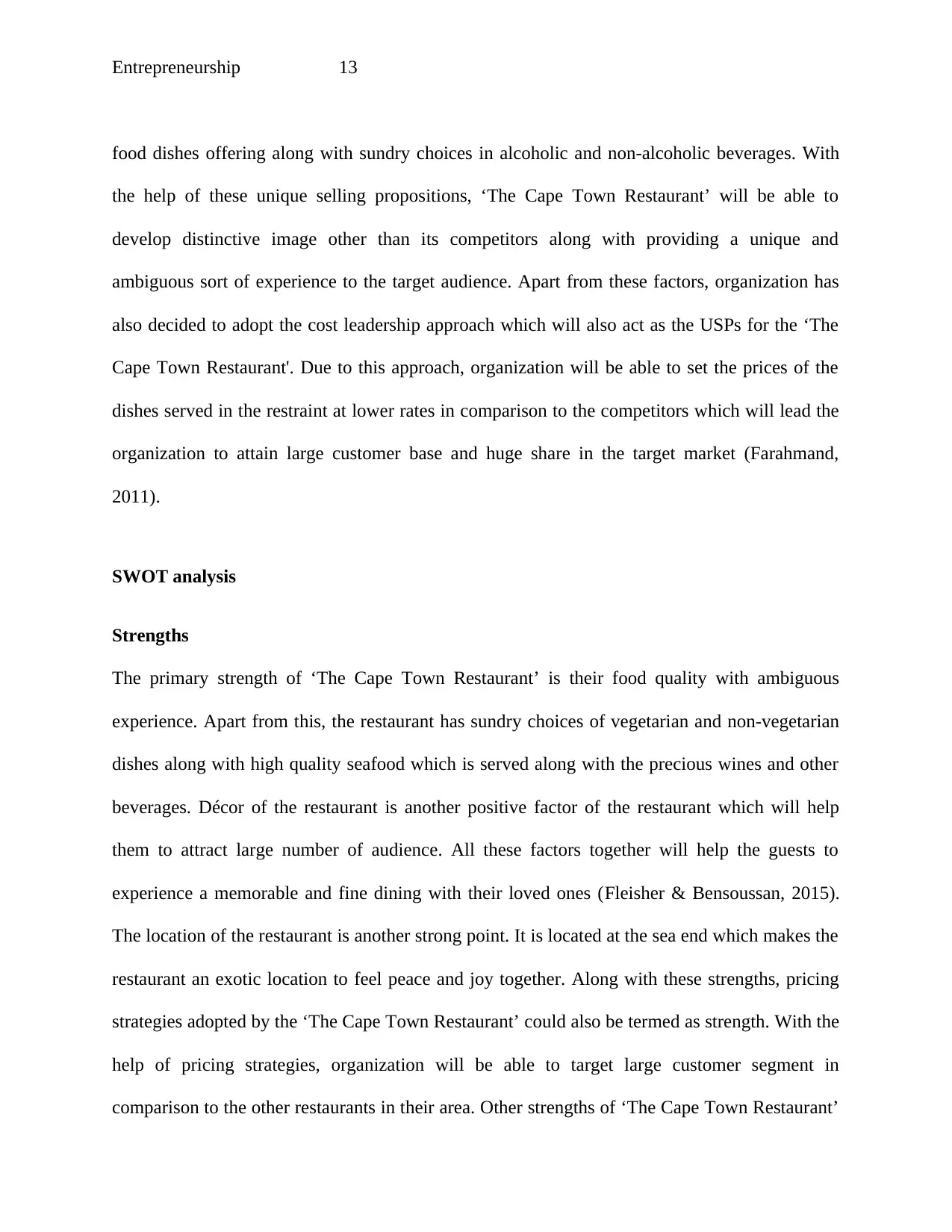
Entrepreneurship 13
food dishes offering along with sundry choices in alcoholic and non-alcoholic beverages. With
the help of these unique selling propositions, ‘The Cape Town Restaurant’ will be able to
develop distinctive image other than its competitors along with providing a unique and
ambiguous sort of experience to the target audience. Apart from these factors, organization has
also decided to adopt the cost leadership approach which will also act as the USPs for the ‘The
Cape Town Restaurant'. Due to this approach, organization will be able to set the prices of the
dishes served in the restraint at lower rates in comparison to the competitors which will lead the
organization to attain large customer base and huge share in the target market (Farahmand,
2011).
SWOT analysis
Strengths
The primary strength of ‘The Cape Town Restaurant’ is their food quality with ambiguous
experience. Apart from this, the restaurant has sundry choices of vegetarian and non-vegetarian
dishes along with high quality seafood which is served along with the precious wines and other
beverages. Décor of the restaurant is another positive factor of the restaurant which will help
them to attract large number of audience. All these factors together will help the guests to
experience a memorable and fine dining with their loved ones (Fleisher & Bensoussan, 2015).
The location of the restaurant is another strong point. It is located at the sea end which makes the
restaurant an exotic location to feel peace and joy together. Along with these strengths, pricing
strategies adopted by the ‘The Cape Town Restaurant’ could also be termed as strength. With the
help of pricing strategies, organization will be able to target large customer segment in
comparison to the other restaurants in their area. Other strengths of ‘The Cape Town Restaurant’
food dishes offering along with sundry choices in alcoholic and non-alcoholic beverages. With
the help of these unique selling propositions, ‘The Cape Town Restaurant’ will be able to
develop distinctive image other than its competitors along with providing a unique and
ambiguous sort of experience to the target audience. Apart from these factors, organization has
also decided to adopt the cost leadership approach which will also act as the USPs for the ‘The
Cape Town Restaurant'. Due to this approach, organization will be able to set the prices of the
dishes served in the restraint at lower rates in comparison to the competitors which will lead the
organization to attain large customer base and huge share in the target market (Farahmand,
2011).
SWOT analysis
Strengths
The primary strength of ‘The Cape Town Restaurant’ is their food quality with ambiguous
experience. Apart from this, the restaurant has sundry choices of vegetarian and non-vegetarian
dishes along with high quality seafood which is served along with the precious wines and other
beverages. Décor of the restaurant is another positive factor of the restaurant which will help
them to attract large number of audience. All these factors together will help the guests to
experience a memorable and fine dining with their loved ones (Fleisher & Bensoussan, 2015).
The location of the restaurant is another strong point. It is located at the sea end which makes the
restaurant an exotic location to feel peace and joy together. Along with these strengths, pricing
strategies adopted by the ‘The Cape Town Restaurant’ could also be termed as strength. With the
help of pricing strategies, organization will be able to target large customer segment in
comparison to the other restaurants in their area. Other strengths of ‘The Cape Town Restaurant’
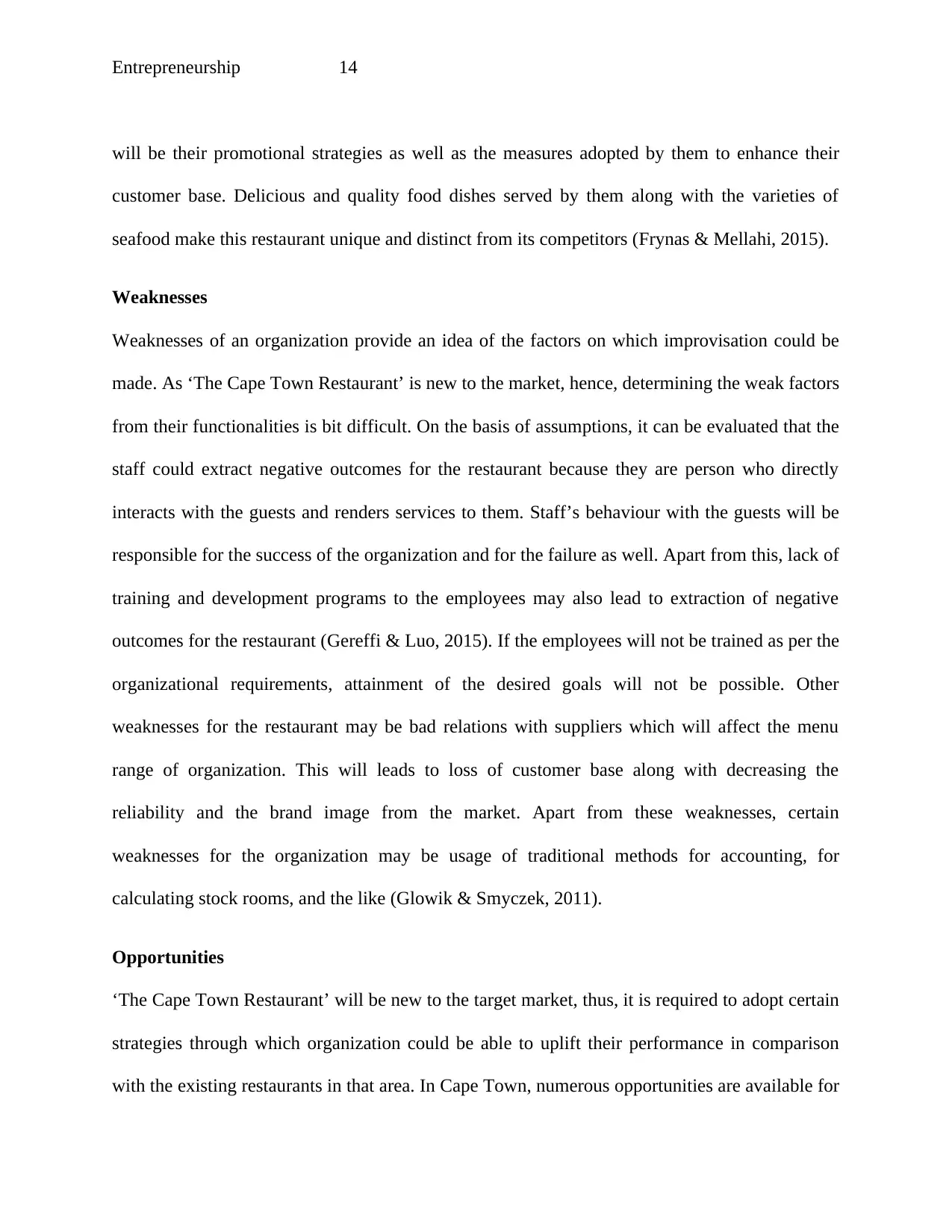
Entrepreneurship 14
will be their promotional strategies as well as the measures adopted by them to enhance their
customer base. Delicious and quality food dishes served by them along with the varieties of
seafood make this restaurant unique and distinct from its competitors (Frynas & Mellahi, 2015).
Weaknesses
Weaknesses of an organization provide an idea of the factors on which improvisation could be
made. As ‘The Cape Town Restaurant’ is new to the market, hence, determining the weak factors
from their functionalities is bit difficult. On the basis of assumptions, it can be evaluated that the
staff could extract negative outcomes for the restaurant because they are person who directly
interacts with the guests and renders services to them. Staff’s behaviour with the guests will be
responsible for the success of the organization and for the failure as well. Apart from this, lack of
training and development programs to the employees may also lead to extraction of negative
outcomes for the restaurant (Gereffi & Luo, 2015). If the employees will not be trained as per the
organizational requirements, attainment of the desired goals will not be possible. Other
weaknesses for the restaurant may be bad relations with suppliers which will affect the menu
range of organization. This will leads to loss of customer base along with decreasing the
reliability and the brand image from the market. Apart from these weaknesses, certain
weaknesses for the organization may be usage of traditional methods for accounting, for
calculating stock rooms, and the like (Glowik & Smyczek, 2011).
Opportunities
‘The Cape Town Restaurant’ will be new to the target market, thus, it is required to adopt certain
strategies through which organization could be able to uplift their performance in comparison
with the existing restaurants in that area. In Cape Town, numerous opportunities are available for
will be their promotional strategies as well as the measures adopted by them to enhance their
customer base. Delicious and quality food dishes served by them along with the varieties of
seafood make this restaurant unique and distinct from its competitors (Frynas & Mellahi, 2015).
Weaknesses
Weaknesses of an organization provide an idea of the factors on which improvisation could be
made. As ‘The Cape Town Restaurant’ is new to the market, hence, determining the weak factors
from their functionalities is bit difficult. On the basis of assumptions, it can be evaluated that the
staff could extract negative outcomes for the restaurant because they are person who directly
interacts with the guests and renders services to them. Staff’s behaviour with the guests will be
responsible for the success of the organization and for the failure as well. Apart from this, lack of
training and development programs to the employees may also lead to extraction of negative
outcomes for the restaurant (Gereffi & Luo, 2015). If the employees will not be trained as per the
organizational requirements, attainment of the desired goals will not be possible. Other
weaknesses for the restaurant may be bad relations with suppliers which will affect the menu
range of organization. This will leads to loss of customer base along with decreasing the
reliability and the brand image from the market. Apart from these weaknesses, certain
weaknesses for the organization may be usage of traditional methods for accounting, for
calculating stock rooms, and the like (Glowik & Smyczek, 2011).
Opportunities
‘The Cape Town Restaurant’ will be new to the target market, thus, it is required to adopt certain
strategies through which organization could be able to uplift their performance in comparison
with the existing restaurants in that area. In Cape Town, numerous opportunities are available for
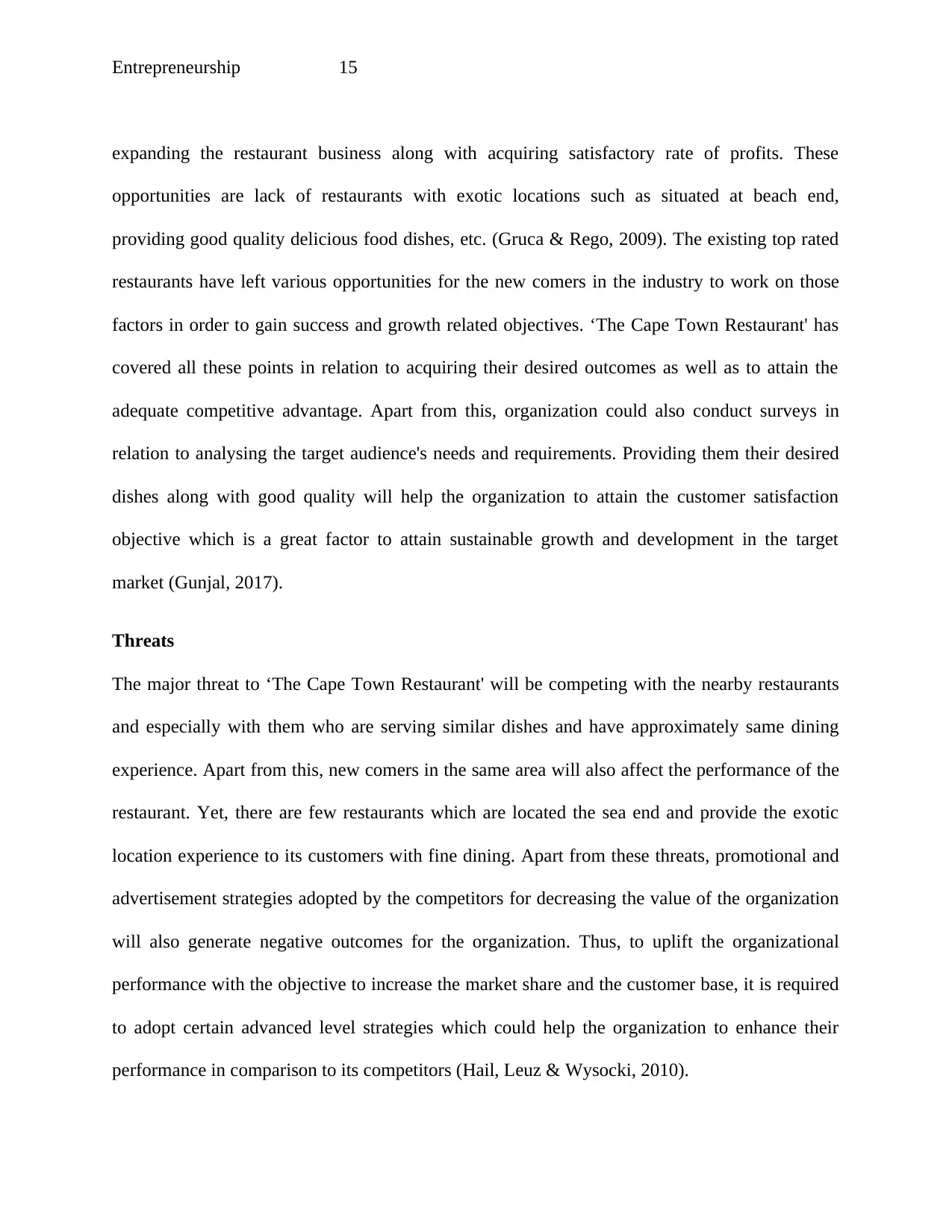
Entrepreneurship 15
expanding the restaurant business along with acquiring satisfactory rate of profits. These
opportunities are lack of restaurants with exotic locations such as situated at beach end,
providing good quality delicious food dishes, etc. (Gruca & Rego, 2009). The existing top rated
restaurants have left various opportunities for the new comers in the industry to work on those
factors in order to gain success and growth related objectives. ‘The Cape Town Restaurant' has
covered all these points in relation to acquiring their desired outcomes as well as to attain the
adequate competitive advantage. Apart from this, organization could also conduct surveys in
relation to analysing the target audience's needs and requirements. Providing them their desired
dishes along with good quality will help the organization to attain the customer satisfaction
objective which is a great factor to attain sustainable growth and development in the target
market (Gunjal, 2017).
Threats
The major threat to ‘The Cape Town Restaurant' will be competing with the nearby restaurants
and especially with them who are serving similar dishes and have approximately same dining
experience. Apart from this, new comers in the same area will also affect the performance of the
restaurant. Yet, there are few restaurants which are located the sea end and provide the exotic
location experience to its customers with fine dining. Apart from these threats, promotional and
advertisement strategies adopted by the competitors for decreasing the value of the organization
will also generate negative outcomes for the organization. Thus, to uplift the organizational
performance with the objective to increase the market share and the customer base, it is required
to adopt certain advanced level strategies which could help the organization to enhance their
performance in comparison to its competitors (Hail, Leuz & Wysocki, 2010).
expanding the restaurant business along with acquiring satisfactory rate of profits. These
opportunities are lack of restaurants with exotic locations such as situated at beach end,
providing good quality delicious food dishes, etc. (Gruca & Rego, 2009). The existing top rated
restaurants have left various opportunities for the new comers in the industry to work on those
factors in order to gain success and growth related objectives. ‘The Cape Town Restaurant' has
covered all these points in relation to acquiring their desired outcomes as well as to attain the
adequate competitive advantage. Apart from this, organization could also conduct surveys in
relation to analysing the target audience's needs and requirements. Providing them their desired
dishes along with good quality will help the organization to attain the customer satisfaction
objective which is a great factor to attain sustainable growth and development in the target
market (Gunjal, 2017).
Threats
The major threat to ‘The Cape Town Restaurant' will be competing with the nearby restaurants
and especially with them who are serving similar dishes and have approximately same dining
experience. Apart from this, new comers in the same area will also affect the performance of the
restaurant. Yet, there are few restaurants which are located the sea end and provide the exotic
location experience to its customers with fine dining. Apart from these threats, promotional and
advertisement strategies adopted by the competitors for decreasing the value of the organization
will also generate negative outcomes for the organization. Thus, to uplift the organizational
performance with the objective to increase the market share and the customer base, it is required
to adopt certain advanced level strategies which could help the organization to enhance their
performance in comparison to its competitors (Hail, Leuz & Wysocki, 2010).
Secure Best Marks with AI Grader
Need help grading? Try our AI Grader for instant feedback on your assignments.
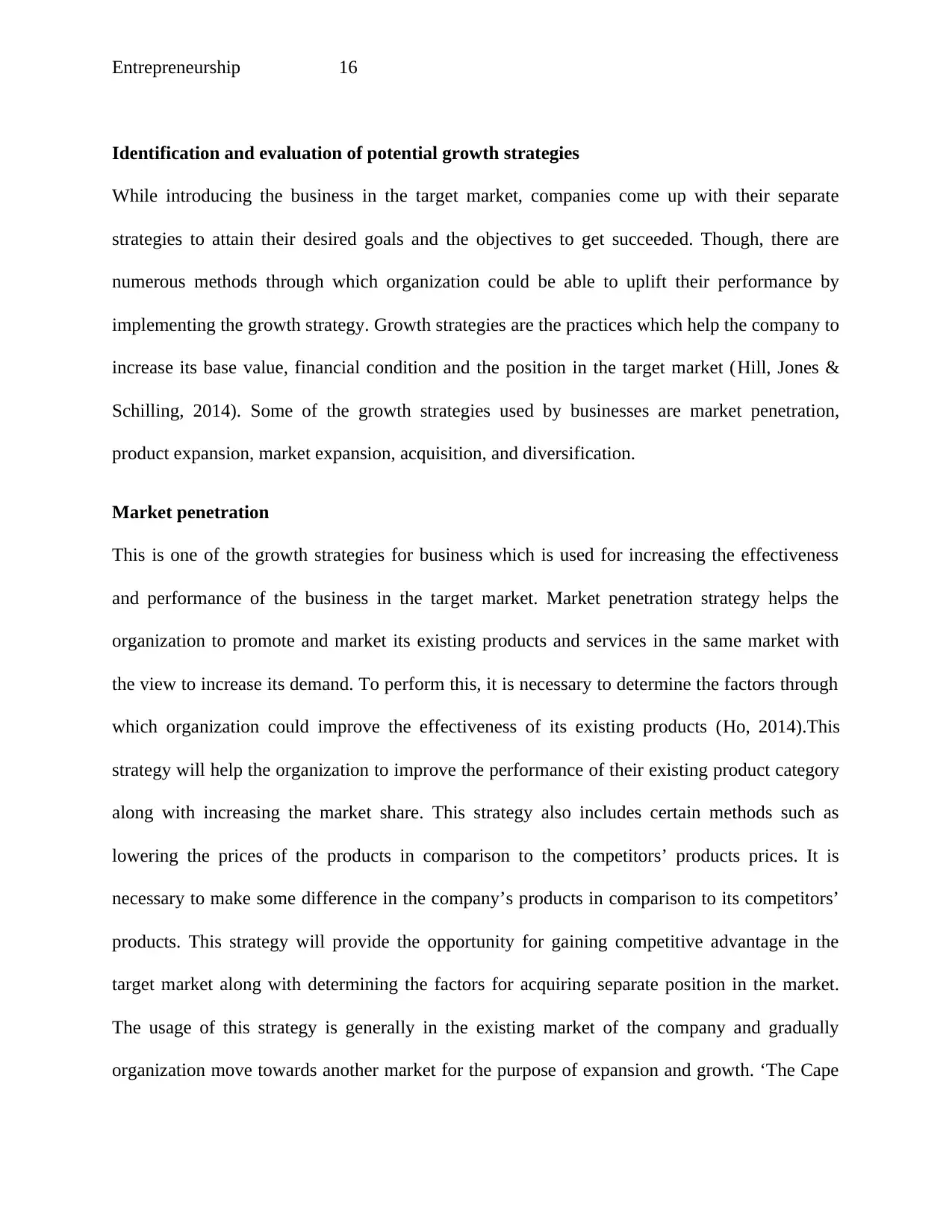
Entrepreneurship 16
Identification and evaluation of potential growth strategies
While introducing the business in the target market, companies come up with their separate
strategies to attain their desired goals and the objectives to get succeeded. Though, there are
numerous methods through which organization could be able to uplift their performance by
implementing the growth strategy. Growth strategies are the practices which help the company to
increase its base value, financial condition and the position in the target market (Hill, Jones &
Schilling, 2014). Some of the growth strategies used by businesses are market penetration,
product expansion, market expansion, acquisition, and diversification.
Market penetration
This is one of the growth strategies for business which is used for increasing the effectiveness
and performance of the business in the target market. Market penetration strategy helps the
organization to promote and market its existing products and services in the same market with
the view to increase its demand. To perform this, it is necessary to determine the factors through
which organization could improve the effectiveness of its existing products (Ho, 2014).This
strategy will help the organization to improve the performance of their existing product category
along with increasing the market share. This strategy also includes certain methods such as
lowering the prices of the products in comparison to the competitors’ products prices. It is
necessary to make some difference in the company’s products in comparison to its competitors’
products. This strategy will provide the opportunity for gaining competitive advantage in the
target market along with determining the factors for acquiring separate position in the market.
The usage of this strategy is generally in the existing market of the company and gradually
organization move towards another market for the purpose of expansion and growth. ‘The Cape
Identification and evaluation of potential growth strategies
While introducing the business in the target market, companies come up with their separate
strategies to attain their desired goals and the objectives to get succeeded. Though, there are
numerous methods through which organization could be able to uplift their performance by
implementing the growth strategy. Growth strategies are the practices which help the company to
increase its base value, financial condition and the position in the target market (Hill, Jones &
Schilling, 2014). Some of the growth strategies used by businesses are market penetration,
product expansion, market expansion, acquisition, and diversification.
Market penetration
This is one of the growth strategies for business which is used for increasing the effectiveness
and performance of the business in the target market. Market penetration strategy helps the
organization to promote and market its existing products and services in the same market with
the view to increase its demand. To perform this, it is necessary to determine the factors through
which organization could improve the effectiveness of its existing products (Ho, 2014).This
strategy will help the organization to improve the performance of their existing product category
along with increasing the market share. This strategy also includes certain methods such as
lowering the prices of the products in comparison to the competitors’ products prices. It is
necessary to make some difference in the company’s products in comparison to its competitors’
products. This strategy will provide the opportunity for gaining competitive advantage in the
target market along with determining the factors for acquiring separate position in the market.
The usage of this strategy is generally in the existing market of the company and gradually
organization move towards another market for the purpose of expansion and growth. ‘The Cape
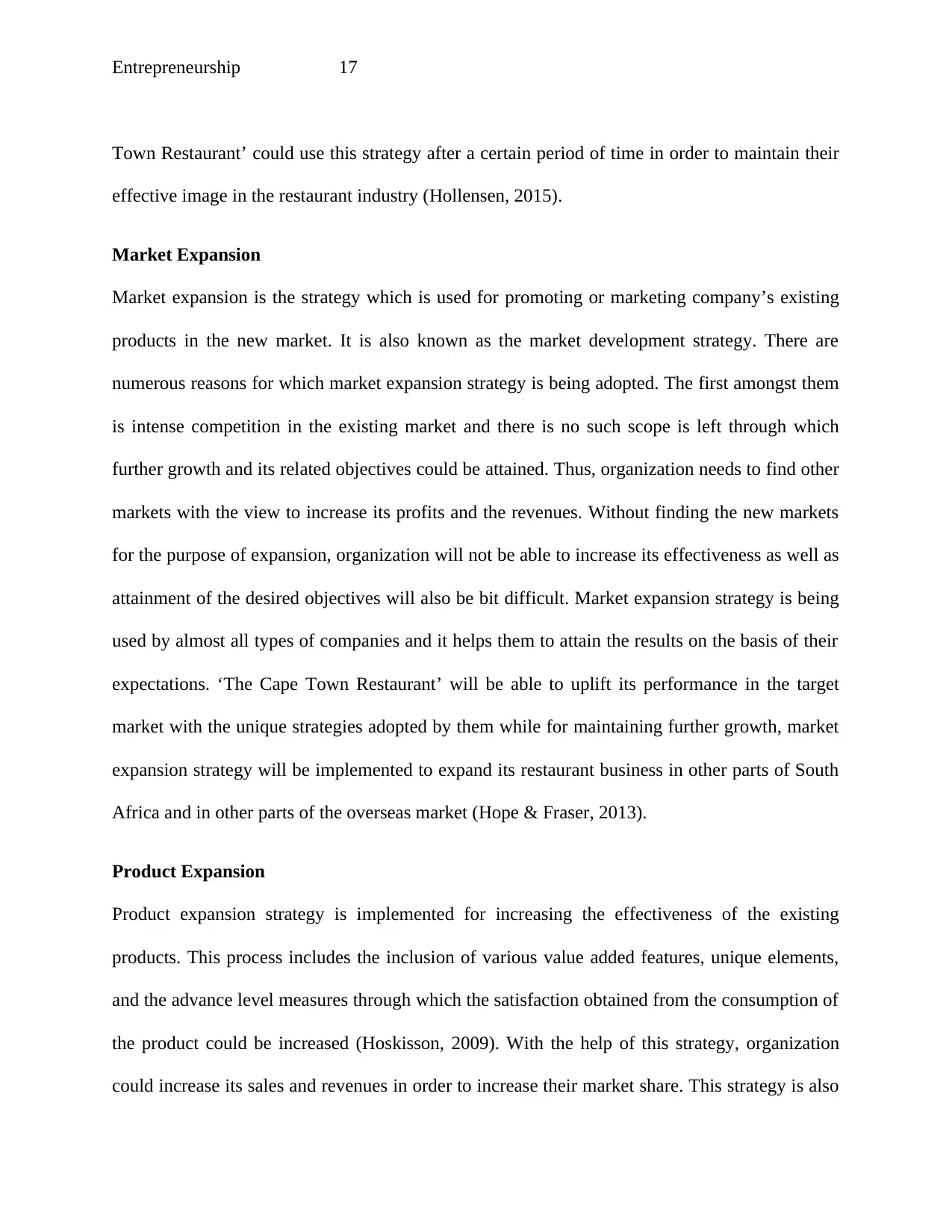
Entrepreneurship 17
Town Restaurant’ could use this strategy after a certain period of time in order to maintain their
effective image in the restaurant industry (Hollensen, 2015).
Market Expansion
Market expansion is the strategy which is used for promoting or marketing company’s existing
products in the new market. It is also known as the market development strategy. There are
numerous reasons for which market expansion strategy is being adopted. The first amongst them
is intense competition in the existing market and there is no such scope is left through which
further growth and its related objectives could be attained. Thus, organization needs to find other
markets with the view to increase its profits and the revenues. Without finding the new markets
for the purpose of expansion, organization will not be able to increase its effectiveness as well as
attainment of the desired objectives will also be bit difficult. Market expansion strategy is being
used by almost all types of companies and it helps them to attain the results on the basis of their
expectations. ‘The Cape Town Restaurant’ will be able to uplift its performance in the target
market with the unique strategies adopted by them while for maintaining further growth, market
expansion strategy will be implemented to expand its restaurant business in other parts of South
Africa and in other parts of the overseas market (Hope & Fraser, 2013).
Product Expansion
Product expansion strategy is implemented for increasing the effectiveness of the existing
products. This process includes the inclusion of various value added features, unique elements,
and the advance level measures through which the satisfaction obtained from the consumption of
the product could be increased (Hoskisson, 2009). With the help of this strategy, organization
could increase its sales and revenues in order to increase their market share. This strategy is also
Town Restaurant’ could use this strategy after a certain period of time in order to maintain their
effective image in the restaurant industry (Hollensen, 2015).
Market Expansion
Market expansion is the strategy which is used for promoting or marketing company’s existing
products in the new market. It is also known as the market development strategy. There are
numerous reasons for which market expansion strategy is being adopted. The first amongst them
is intense competition in the existing market and there is no such scope is left through which
further growth and its related objectives could be attained. Thus, organization needs to find other
markets with the view to increase its profits and the revenues. Without finding the new markets
for the purpose of expansion, organization will not be able to increase its effectiveness as well as
attainment of the desired objectives will also be bit difficult. Market expansion strategy is being
used by almost all types of companies and it helps them to attain the results on the basis of their
expectations. ‘The Cape Town Restaurant’ will be able to uplift its performance in the target
market with the unique strategies adopted by them while for maintaining further growth, market
expansion strategy will be implemented to expand its restaurant business in other parts of South
Africa and in other parts of the overseas market (Hope & Fraser, 2013).
Product Expansion
Product expansion strategy is implemented for increasing the effectiveness of the existing
products. This process includes the inclusion of various value added features, unique elements,
and the advance level measures through which the satisfaction obtained from the consumption of
the product could be increased (Hoskisson, 2009). With the help of this strategy, organization
could increase its sales and revenues in order to increase their market share. This strategy is also

Entrepreneurship 18
known as the product development and after application of this strategy; the company continues
to sell its products in both existing markets and in the new markets with the motive of increasing
the profitability and revenues. This strategy is also being applied for the adopting the
technological changes as these factors play crucial role in order to increase the effectiveness of
the organizational products. Due to diversified and dynamic nature of business environment,
organization needs to adopt change in their functionalities with the motive to enhance their
performance in the target market (Jie, Parton & Chan, 2015).
Diversification
Diversification strategy is important aspect for attaining the growth related objectives and under
this strategy, existing organization produces new products on the basis of target audiences’
requirements and sells them into new markets. This strategy is bit risky as compared to other
strategies of growth. Thus, before implementing this into the marketplace, it is required to
conduct market research activities for analysing the requirement of the target audience along
with the marking environmental factors of the new market (Joshi, 2009). New produced products
should be capable enough to fulfil the desires and needs of the potential consumers so that
appropriate goals could be attained easily. Diversification is a part of business and it should be
adopted by every business entity for increasing the choices for the target audience along with
fulfilling their needs in terms of attaining the desired goals and the objectives. Diversification
strategy could be adopted by the ‘The Cape Town Restaurant’ with the view to expand its
business in the other parts of the country along with ascertaining the factors for expanding the
business in the overseas market (Kim & Hyun, 2011).
known as the product development and after application of this strategy; the company continues
to sell its products in both existing markets and in the new markets with the motive of increasing
the profitability and revenues. This strategy is also being applied for the adopting the
technological changes as these factors play crucial role in order to increase the effectiveness of
the organizational products. Due to diversified and dynamic nature of business environment,
organization needs to adopt change in their functionalities with the motive to enhance their
performance in the target market (Jie, Parton & Chan, 2015).
Diversification
Diversification strategy is important aspect for attaining the growth related objectives and under
this strategy, existing organization produces new products on the basis of target audiences’
requirements and sells them into new markets. This strategy is bit risky as compared to other
strategies of growth. Thus, before implementing this into the marketplace, it is required to
conduct market research activities for analysing the requirement of the target audience along
with the marking environmental factors of the new market (Joshi, 2009). New produced products
should be capable enough to fulfil the desires and needs of the potential consumers so that
appropriate goals could be attained easily. Diversification is a part of business and it should be
adopted by every business entity for increasing the choices for the target audience along with
fulfilling their needs in terms of attaining the desired goals and the objectives. Diversification
strategy could be adopted by the ‘The Cape Town Restaurant’ with the view to expand its
business in the other parts of the country along with ascertaining the factors for expanding the
business in the overseas market (Kim & Hyun, 2011).
Paraphrase This Document
Need a fresh take? Get an instant paraphrase of this document with our AI Paraphraser
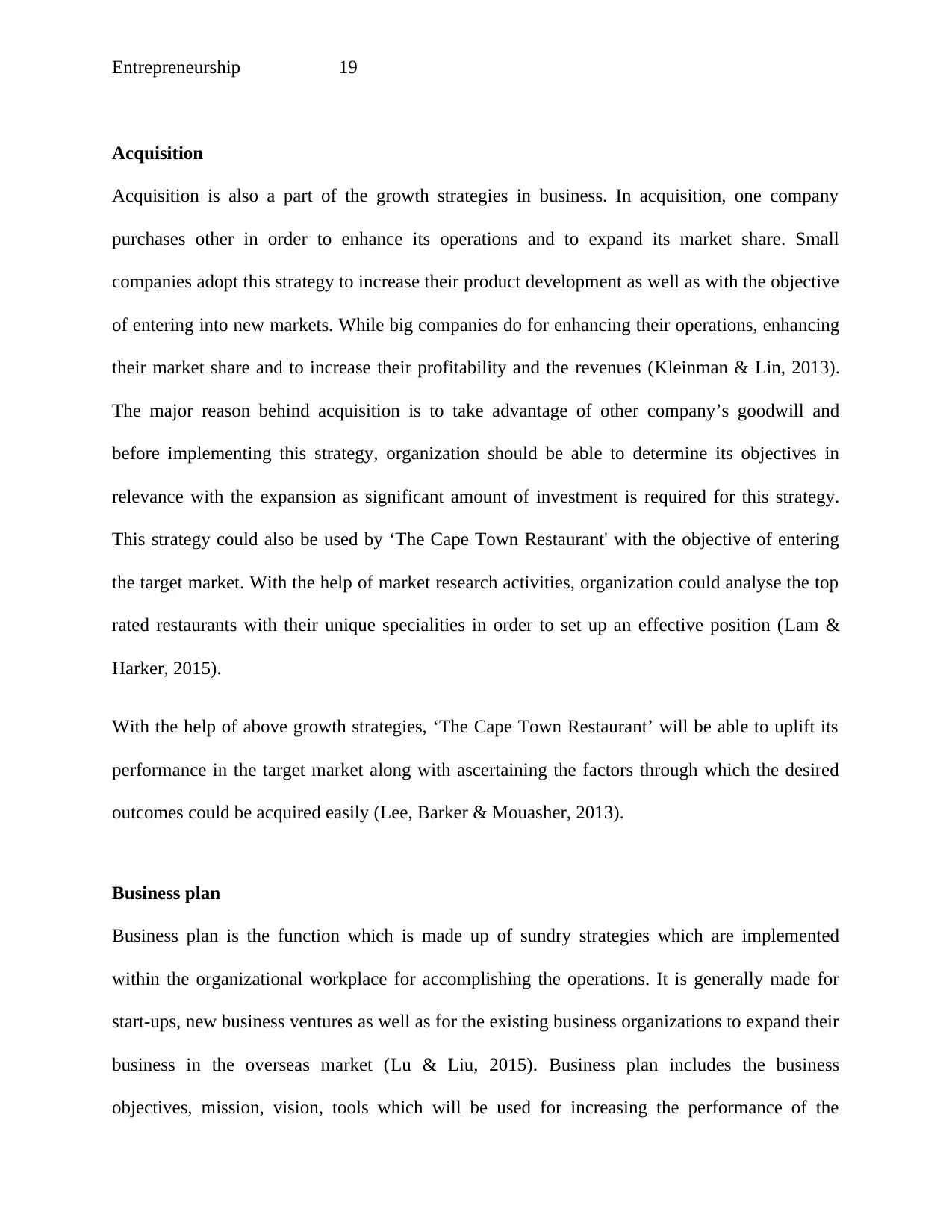
Entrepreneurship 19
Acquisition
Acquisition is also a part of the growth strategies in business. In acquisition, one company
purchases other in order to enhance its operations and to expand its market share. Small
companies adopt this strategy to increase their product development as well as with the objective
of entering into new markets. While big companies do for enhancing their operations, enhancing
their market share and to increase their profitability and the revenues (Kleinman & Lin, 2013).
The major reason behind acquisition is to take advantage of other company’s goodwill and
before implementing this strategy, organization should be able to determine its objectives in
relevance with the expansion as significant amount of investment is required for this strategy.
This strategy could also be used by ‘The Cape Town Restaurant' with the objective of entering
the target market. With the help of market research activities, organization could analyse the top
rated restaurants with their unique specialities in order to set up an effective position (Lam &
Harker, 2015).
With the help of above growth strategies, ‘The Cape Town Restaurant’ will be able to uplift its
performance in the target market along with ascertaining the factors through which the desired
outcomes could be acquired easily (Lee, Barker & Mouasher, 2013).
Business plan
Business plan is the function which is made up of sundry strategies which are implemented
within the organizational workplace for accomplishing the operations. It is generally made for
start-ups, new business ventures as well as for the existing business organizations to expand their
business in the overseas market (Lu & Liu, 2015). Business plan includes the business
objectives, mission, vision, tools which will be used for increasing the performance of the
Acquisition
Acquisition is also a part of the growth strategies in business. In acquisition, one company
purchases other in order to enhance its operations and to expand its market share. Small
companies adopt this strategy to increase their product development as well as with the objective
of entering into new markets. While big companies do for enhancing their operations, enhancing
their market share and to increase their profitability and the revenues (Kleinman & Lin, 2013).
The major reason behind acquisition is to take advantage of other company’s goodwill and
before implementing this strategy, organization should be able to determine its objectives in
relevance with the expansion as significant amount of investment is required for this strategy.
This strategy could also be used by ‘The Cape Town Restaurant' with the objective of entering
the target market. With the help of market research activities, organization could analyse the top
rated restaurants with their unique specialities in order to set up an effective position (Lam &
Harker, 2015).
With the help of above growth strategies, ‘The Cape Town Restaurant’ will be able to uplift its
performance in the target market along with ascertaining the factors through which the desired
outcomes could be acquired easily (Lee, Barker & Mouasher, 2013).
Business plan
Business plan is the function which is made up of sundry strategies which are implemented
within the organizational workplace for accomplishing the operations. It is generally made for
start-ups, new business ventures as well as for the existing business organizations to expand their
business in the overseas market (Lu & Liu, 2015). Business plan includes the business
objectives, mission, vision, tools which will be used for increasing the performance of the
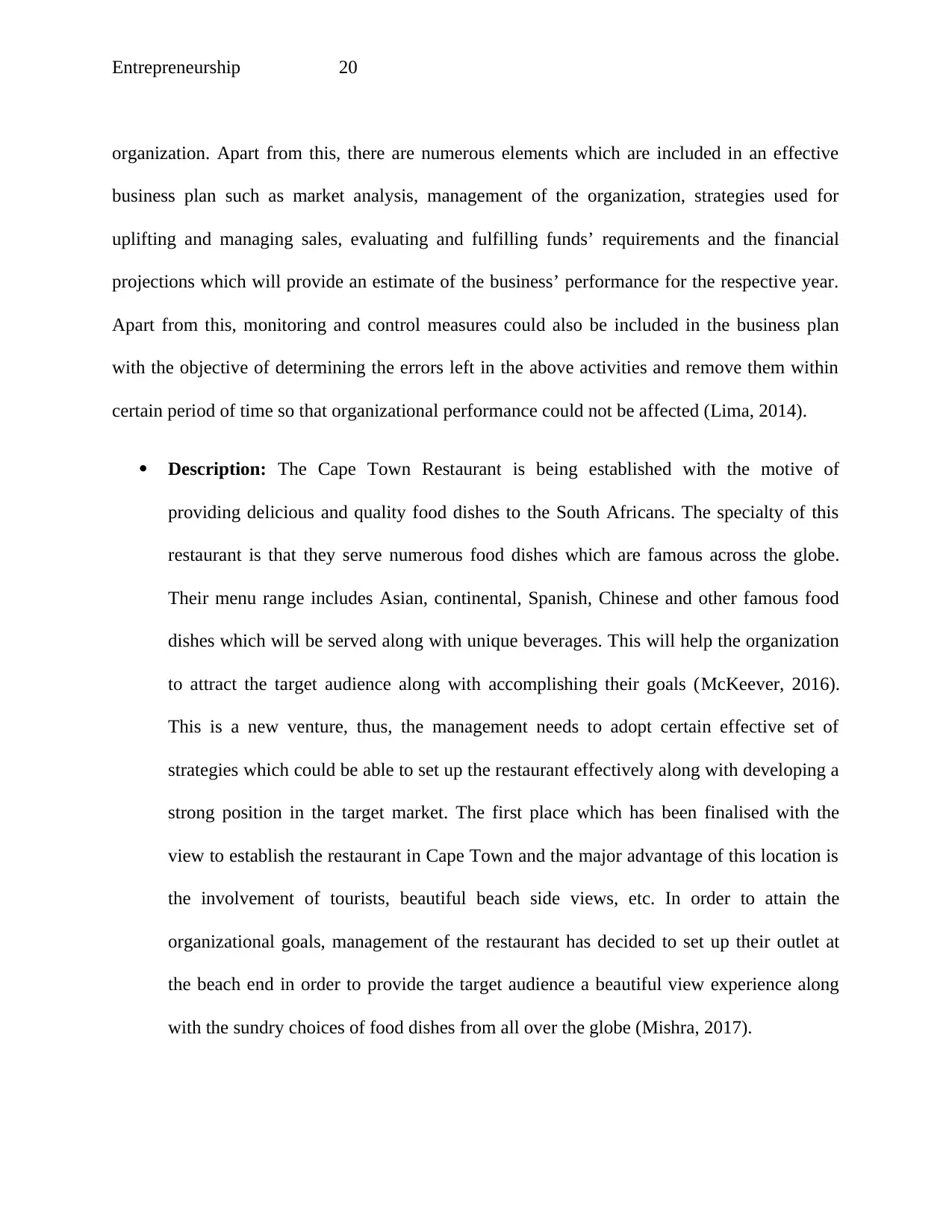
Entrepreneurship 20
organization. Apart from this, there are numerous elements which are included in an effective
business plan such as market analysis, management of the organization, strategies used for
uplifting and managing sales, evaluating and fulfilling funds’ requirements and the financial
projections which will provide an estimate of the business’ performance for the respective year.
Apart from this, monitoring and control measures could also be included in the business plan
with the objective of determining the errors left in the above activities and remove them within
certain period of time so that organizational performance could not be affected (Lima, 2014).
Description: The Cape Town Restaurant is being established with the motive of
providing delicious and quality food dishes to the South Africans. The specialty of this
restaurant is that they serve numerous food dishes which are famous across the globe.
Their menu range includes Asian, continental, Spanish, Chinese and other famous food
dishes which will be served along with unique beverages. This will help the organization
to attract the target audience along with accomplishing their goals (McKeever, 2016).
This is a new venture, thus, the management needs to adopt certain effective set of
strategies which could be able to set up the restaurant effectively along with developing a
strong position in the target market. The first place which has been finalised with the
view to establish the restaurant in Cape Town and the major advantage of this location is
the involvement of tourists, beautiful beach side views, etc. In order to attain the
organizational goals, management of the restaurant has decided to set up their outlet at
the beach end in order to provide the target audience a beautiful view experience along
with the sundry choices of food dishes from all over the globe (Mishra, 2017).
organization. Apart from this, there are numerous elements which are included in an effective
business plan such as market analysis, management of the organization, strategies used for
uplifting and managing sales, evaluating and fulfilling funds’ requirements and the financial
projections which will provide an estimate of the business’ performance for the respective year.
Apart from this, monitoring and control measures could also be included in the business plan
with the objective of determining the errors left in the above activities and remove them within
certain period of time so that organizational performance could not be affected (Lima, 2014).
Description: The Cape Town Restaurant is being established with the motive of
providing delicious and quality food dishes to the South Africans. The specialty of this
restaurant is that they serve numerous food dishes which are famous across the globe.
Their menu range includes Asian, continental, Spanish, Chinese and other famous food
dishes which will be served along with unique beverages. This will help the organization
to attract the target audience along with accomplishing their goals (McKeever, 2016).
This is a new venture, thus, the management needs to adopt certain effective set of
strategies which could be able to set up the restaurant effectively along with developing a
strong position in the target market. The first place which has been finalised with the
view to establish the restaurant in Cape Town and the major advantage of this location is
the involvement of tourists, beautiful beach side views, etc. In order to attain the
organizational goals, management of the restaurant has decided to set up their outlet at
the beach end in order to provide the target audience a beautiful view experience along
with the sundry choices of food dishes from all over the globe (Mishra, 2017).
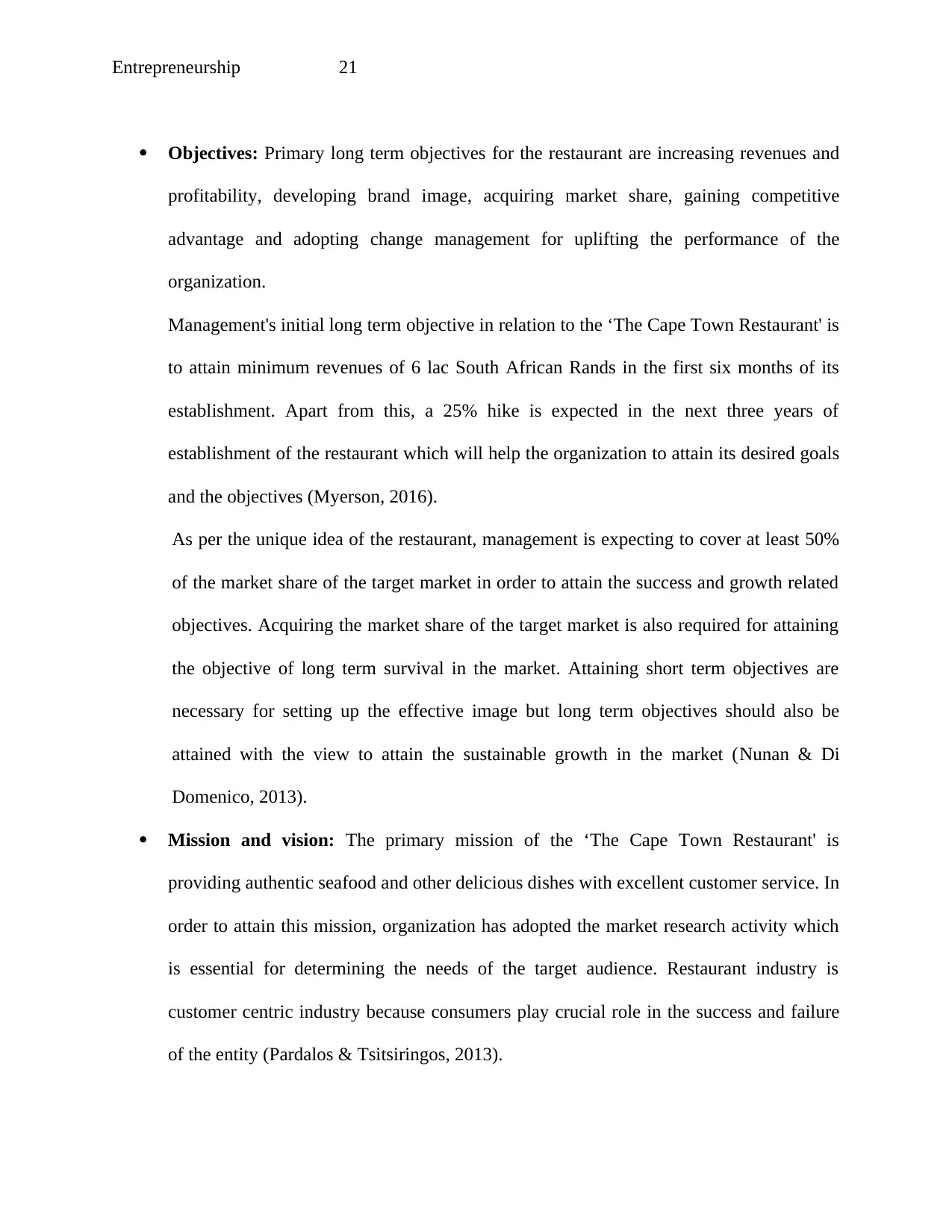
Entrepreneurship 21
Objectives: Primary long term objectives for the restaurant are increasing revenues and
profitability, developing brand image, acquiring market share, gaining competitive
advantage and adopting change management for uplifting the performance of the
organization.
Management's initial long term objective in relation to the ‘The Cape Town Restaurant' is
to attain minimum revenues of 6 lac South African Rands in the first six months of its
establishment. Apart from this, a 25% hike is expected in the next three years of
establishment of the restaurant which will help the organization to attain its desired goals
and the objectives (Myerson, 2016).
As per the unique idea of the restaurant, management is expecting to cover at least 50%
of the market share of the target market in order to attain the success and growth related
objectives. Acquiring the market share of the target market is also required for attaining
the objective of long term survival in the market. Attaining short term objectives are
necessary for setting up the effective image but long term objectives should also be
attained with the view to attain the sustainable growth in the market (Nunan & Di
Domenico, 2013).
Mission and vision: The primary mission of the ‘The Cape Town Restaurant' is
providing authentic seafood and other delicious dishes with excellent customer service. In
order to attain this mission, organization has adopted the market research activity which
is essential for determining the needs of the target audience. Restaurant industry is
customer centric industry because consumers play crucial role in the success and failure
of the entity (Pardalos & Tsitsiringos, 2013).
Objectives: Primary long term objectives for the restaurant are increasing revenues and
profitability, developing brand image, acquiring market share, gaining competitive
advantage and adopting change management for uplifting the performance of the
organization.
Management's initial long term objective in relation to the ‘The Cape Town Restaurant' is
to attain minimum revenues of 6 lac South African Rands in the first six months of its
establishment. Apart from this, a 25% hike is expected in the next three years of
establishment of the restaurant which will help the organization to attain its desired goals
and the objectives (Myerson, 2016).
As per the unique idea of the restaurant, management is expecting to cover at least 50%
of the market share of the target market in order to attain the success and growth related
objectives. Acquiring the market share of the target market is also required for attaining
the objective of long term survival in the market. Attaining short term objectives are
necessary for setting up the effective image but long term objectives should also be
attained with the view to attain the sustainable growth in the market (Nunan & Di
Domenico, 2013).
Mission and vision: The primary mission of the ‘The Cape Town Restaurant' is
providing authentic seafood and other delicious dishes with excellent customer service. In
order to attain this mission, organization has adopted the market research activity which
is essential for determining the needs of the target audience. Restaurant industry is
customer centric industry because consumers play crucial role in the success and failure
of the entity (Pardalos & Tsitsiringos, 2013).
Secure Best Marks with AI Grader
Need help grading? Try our AI Grader for instant feedback on your assignments.
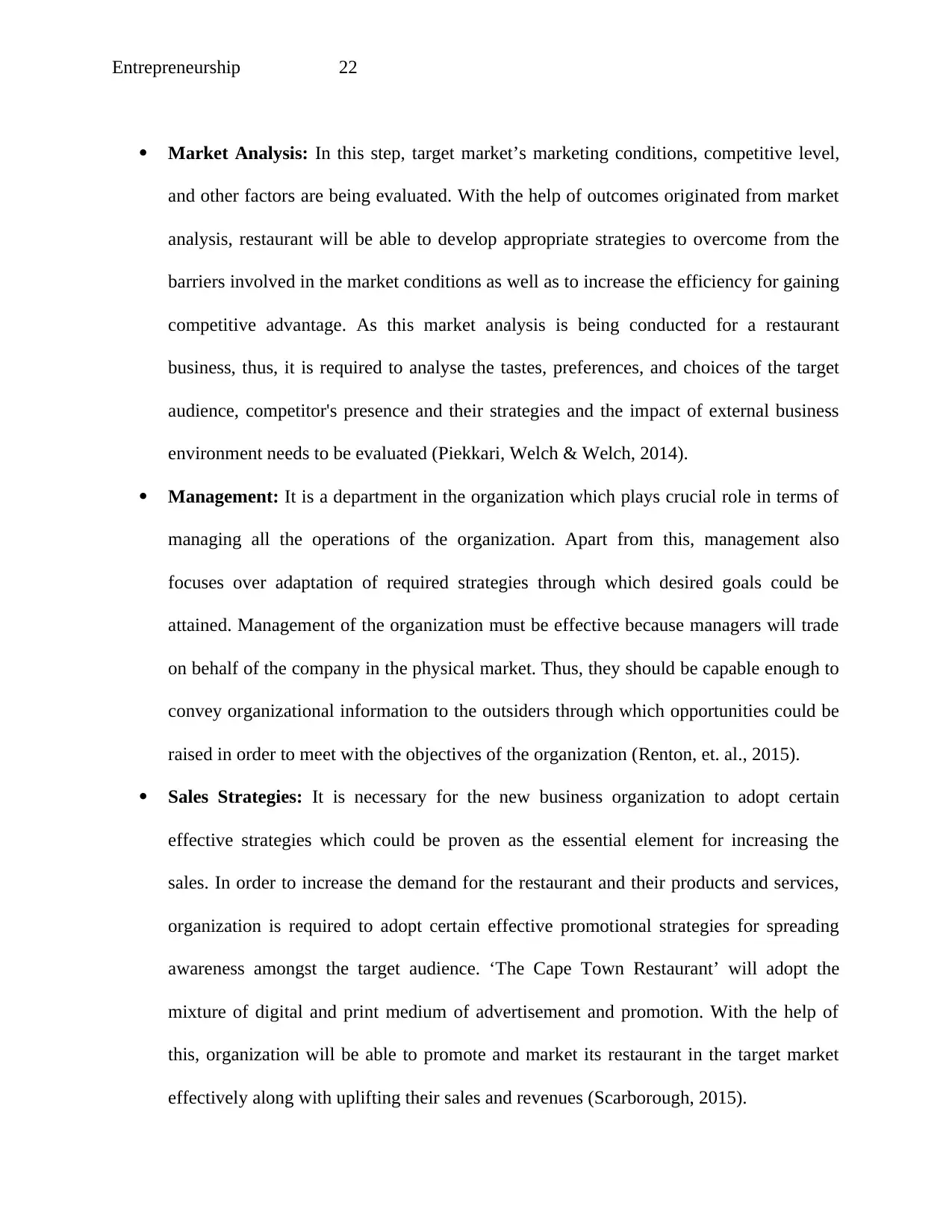
Entrepreneurship 22
Market Analysis: In this step, target market’s marketing conditions, competitive level,
and other factors are being evaluated. With the help of outcomes originated from market
analysis, restaurant will be able to develop appropriate strategies to overcome from the
barriers involved in the market conditions as well as to increase the efficiency for gaining
competitive advantage. As this market analysis is being conducted for a restaurant
business, thus, it is required to analyse the tastes, preferences, and choices of the target
audience, competitor's presence and their strategies and the impact of external business
environment needs to be evaluated (Piekkari, Welch & Welch, 2014).
Management: It is a department in the organization which plays crucial role in terms of
managing all the operations of the organization. Apart from this, management also
focuses over adaptation of required strategies through which desired goals could be
attained. Management of the organization must be effective because managers will trade
on behalf of the company in the physical market. Thus, they should be capable enough to
convey organizational information to the outsiders through which opportunities could be
raised in order to meet with the objectives of the organization (Renton, et. al., 2015).
Sales Strategies: It is necessary for the new business organization to adopt certain
effective strategies which could be proven as the essential element for increasing the
sales. In order to increase the demand for the restaurant and their products and services,
organization is required to adopt certain effective promotional strategies for spreading
awareness amongst the target audience. ‘The Cape Town Restaurant’ will adopt the
mixture of digital and print medium of advertisement and promotion. With the help of
this, organization will be able to promote and market its restaurant in the target market
effectively along with uplifting their sales and revenues (Scarborough, 2015).
Market Analysis: In this step, target market’s marketing conditions, competitive level,
and other factors are being evaluated. With the help of outcomes originated from market
analysis, restaurant will be able to develop appropriate strategies to overcome from the
barriers involved in the market conditions as well as to increase the efficiency for gaining
competitive advantage. As this market analysis is being conducted for a restaurant
business, thus, it is required to analyse the tastes, preferences, and choices of the target
audience, competitor's presence and their strategies and the impact of external business
environment needs to be evaluated (Piekkari, Welch & Welch, 2014).
Management: It is a department in the organization which plays crucial role in terms of
managing all the operations of the organization. Apart from this, management also
focuses over adaptation of required strategies through which desired goals could be
attained. Management of the organization must be effective because managers will trade
on behalf of the company in the physical market. Thus, they should be capable enough to
convey organizational information to the outsiders through which opportunities could be
raised in order to meet with the objectives of the organization (Renton, et. al., 2015).
Sales Strategies: It is necessary for the new business organization to adopt certain
effective strategies which could be proven as the essential element for increasing the
sales. In order to increase the demand for the restaurant and their products and services,
organization is required to adopt certain effective promotional strategies for spreading
awareness amongst the target audience. ‘The Cape Town Restaurant’ will adopt the
mixture of digital and print medium of advertisement and promotion. With the help of
this, organization will be able to promote and market its restaurant in the target market
effectively along with uplifting their sales and revenues (Scarborough, 2015).

Entrepreneurship 23
Funding Requirements: For executing any business, it is required to arrange sufficing
funds in order to allocate them to the respective departments of the organization. For
arranging the funds for setting up the new business venture, an effective business plan
with appropriate and realistic objective is required. This will help the organization to
attract the investors for fulfilling the business' requirements in relation to funds. After
arranging the funds, management needs to allocate the funds on the basis of departmental
requirements. This will help the organization to perform their operations in an
appropriate manner (Scholes, 2015).
Financial Projections: This is the last section of business plan which includes financial
projections. This section also includes making reserves for meeting up with the uncertain
expenses and for expanding the business in near future. Projections related to funds are
based on the factors of growth and market trends. This also includes the information
regarding the sales strategies, realistic objectives and on the basis of organizational
current position (Scott & Walker, 2017).
Monitoring and control: This part of the business plan is optional as it is a rectification
process under which all the above functionalities to be included in the business plan are
analysed. The major motive of this analysis is to detect the errors and mistakes in
different sections of the business plan. If any error or mistake is found, then appropriate
measures need to be applied in order to remove from the steps for attaining the expected
outcomes (Stahl & Tung, 2015).
Funding Requirements: For executing any business, it is required to arrange sufficing
funds in order to allocate them to the respective departments of the organization. For
arranging the funds for setting up the new business venture, an effective business plan
with appropriate and realistic objective is required. This will help the organization to
attract the investors for fulfilling the business' requirements in relation to funds. After
arranging the funds, management needs to allocate the funds on the basis of departmental
requirements. This will help the organization to perform their operations in an
appropriate manner (Scholes, 2015).
Financial Projections: This is the last section of business plan which includes financial
projections. This section also includes making reserves for meeting up with the uncertain
expenses and for expanding the business in near future. Projections related to funds are
based on the factors of growth and market trends. This also includes the information
regarding the sales strategies, realistic objectives and on the basis of organizational
current position (Scott & Walker, 2017).
Monitoring and control: This part of the business plan is optional as it is a rectification
process under which all the above functionalities to be included in the business plan are
analysed. The major motive of this analysis is to detect the errors and mistakes in
different sections of the business plan. If any error or mistake is found, then appropriate
measures need to be applied in order to remove from the steps for attaining the expected
outcomes (Stahl & Tung, 2015).

Entrepreneurship 24
Conclusion
From the aforesaid information, it can be concluded that the business plan is an essential element
for the success of an organization. With the help of this factor, organization could be able to
attract the investors and fulfils its financial requirements for executing the operations of the
organization. In this report, business plan is made up in relation to the ‘The Cape Town
Restaurant'. It is a new business idea which will be opened in Cape Town, South Africa with the
motive of accomplishing its desired goals. Before setting up the restaurant in the target market,
certain marketing activities have been performed for evaluating the marketing conditions of the
target market and for evaluating the scope of restaurant in that area. The idea of this restaurant is
unique and it will be opened at the sea end at beach side which will provide an exotic location to
the restaurant. With the exotic location, restaurant will serve delicious dishes along with the
unique dining experience. This will make the restaurant distinct from the existing restaurants
located in the target market. For making this business idea an effective reality, various functions
have been executed in this report. The first phase of the report concluded the objectives, mission,
and vision of the business idea. Further, it report includes competitive and industry analysis with
the motive of analysing the marketing conditions and the market share acquired by its primary
competitors. The next part of the report includes SWOT analysis, identification, and evaluation
of potential growth strategies through which organizational desired objectives would be attained.
References
Abidi, H., Shafiq, F., Arshad, R., Pirwani, M. and Hassan, A., 2015. Case Study: Stories of
Entrepreneurship. Market Forces, 10(2).
Conclusion
From the aforesaid information, it can be concluded that the business plan is an essential element
for the success of an organization. With the help of this factor, organization could be able to
attract the investors and fulfils its financial requirements for executing the operations of the
organization. In this report, business plan is made up in relation to the ‘The Cape Town
Restaurant'. It is a new business idea which will be opened in Cape Town, South Africa with the
motive of accomplishing its desired goals. Before setting up the restaurant in the target market,
certain marketing activities have been performed for evaluating the marketing conditions of the
target market and for evaluating the scope of restaurant in that area. The idea of this restaurant is
unique and it will be opened at the sea end at beach side which will provide an exotic location to
the restaurant. With the exotic location, restaurant will serve delicious dishes along with the
unique dining experience. This will make the restaurant distinct from the existing restaurants
located in the target market. For making this business idea an effective reality, various functions
have been executed in this report. The first phase of the report concluded the objectives, mission,
and vision of the business idea. Further, it report includes competitive and industry analysis with
the motive of analysing the marketing conditions and the market share acquired by its primary
competitors. The next part of the report includes SWOT analysis, identification, and evaluation
of potential growth strategies through which organizational desired objectives would be attained.
References
Abidi, H., Shafiq, F., Arshad, R., Pirwani, M. and Hassan, A., 2015. Case Study: Stories of
Entrepreneurship. Market Forces, 10(2).
Paraphrase This Document
Need a fresh take? Get an instant paraphrase of this document with our AI Paraphraser
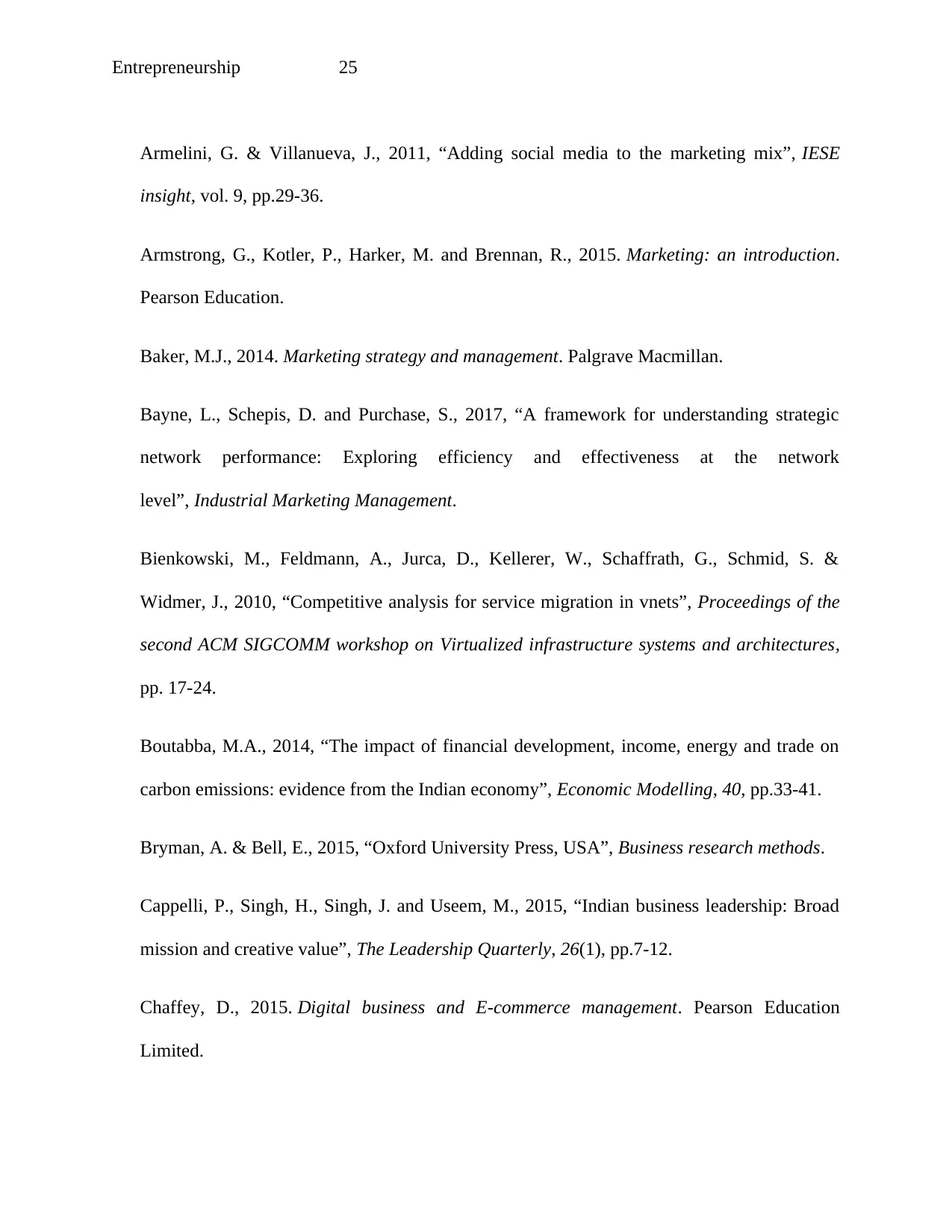
Entrepreneurship 25
Armelini, G. & Villanueva, J., 2011, “Adding social media to the marketing mix”, IESE
insight, vol. 9, pp.29-36.
Armstrong, G., Kotler, P., Harker, M. and Brennan, R., 2015. Marketing: an introduction.
Pearson Education.
Baker, M.J., 2014. Marketing strategy and management. Palgrave Macmillan.
Bayne, L., Schepis, D. and Purchase, S., 2017, “A framework for understanding strategic
network performance: Exploring efficiency and effectiveness at the network
level”, Industrial Marketing Management.
Bienkowski, M., Feldmann, A., Jurca, D., Kellerer, W., Schaffrath, G., Schmid, S. &
Widmer, J., 2010, “Competitive analysis for service migration in vnets”, Proceedings of the
second ACM SIGCOMM workshop on Virtualized infrastructure systems and architectures,
pp. 17-24.
Boutabba, M.A., 2014, “The impact of financial development, income, energy and trade on
carbon emissions: evidence from the Indian economy”, Economic Modelling, 40, pp.33-41.
Bryman, A. & Bell, E., 2015, “Oxford University Press, USA”, Business research methods.
Cappelli, P., Singh, H., Singh, J. and Useem, M., 2015, “Indian business leadership: Broad
mission and creative value”, The Leadership Quarterly, 26(1), pp.7-12.
Chaffey, D., 2015. Digital business and E-commerce management. Pearson Education
Limited.
Armelini, G. & Villanueva, J., 2011, “Adding social media to the marketing mix”, IESE
insight, vol. 9, pp.29-36.
Armstrong, G., Kotler, P., Harker, M. and Brennan, R., 2015. Marketing: an introduction.
Pearson Education.
Baker, M.J., 2014. Marketing strategy and management. Palgrave Macmillan.
Bayne, L., Schepis, D. and Purchase, S., 2017, “A framework for understanding strategic
network performance: Exploring efficiency and effectiveness at the network
level”, Industrial Marketing Management.
Bienkowski, M., Feldmann, A., Jurca, D., Kellerer, W., Schaffrath, G., Schmid, S. &
Widmer, J., 2010, “Competitive analysis for service migration in vnets”, Proceedings of the
second ACM SIGCOMM workshop on Virtualized infrastructure systems and architectures,
pp. 17-24.
Boutabba, M.A., 2014, “The impact of financial development, income, energy and trade on
carbon emissions: evidence from the Indian economy”, Economic Modelling, 40, pp.33-41.
Bryman, A. & Bell, E., 2015, “Oxford University Press, USA”, Business research methods.
Cappelli, P., Singh, H., Singh, J. and Useem, M., 2015, “Indian business leadership: Broad
mission and creative value”, The Leadership Quarterly, 26(1), pp.7-12.
Chaffey, D., 2015. Digital business and E-commerce management. Pearson Education
Limited.
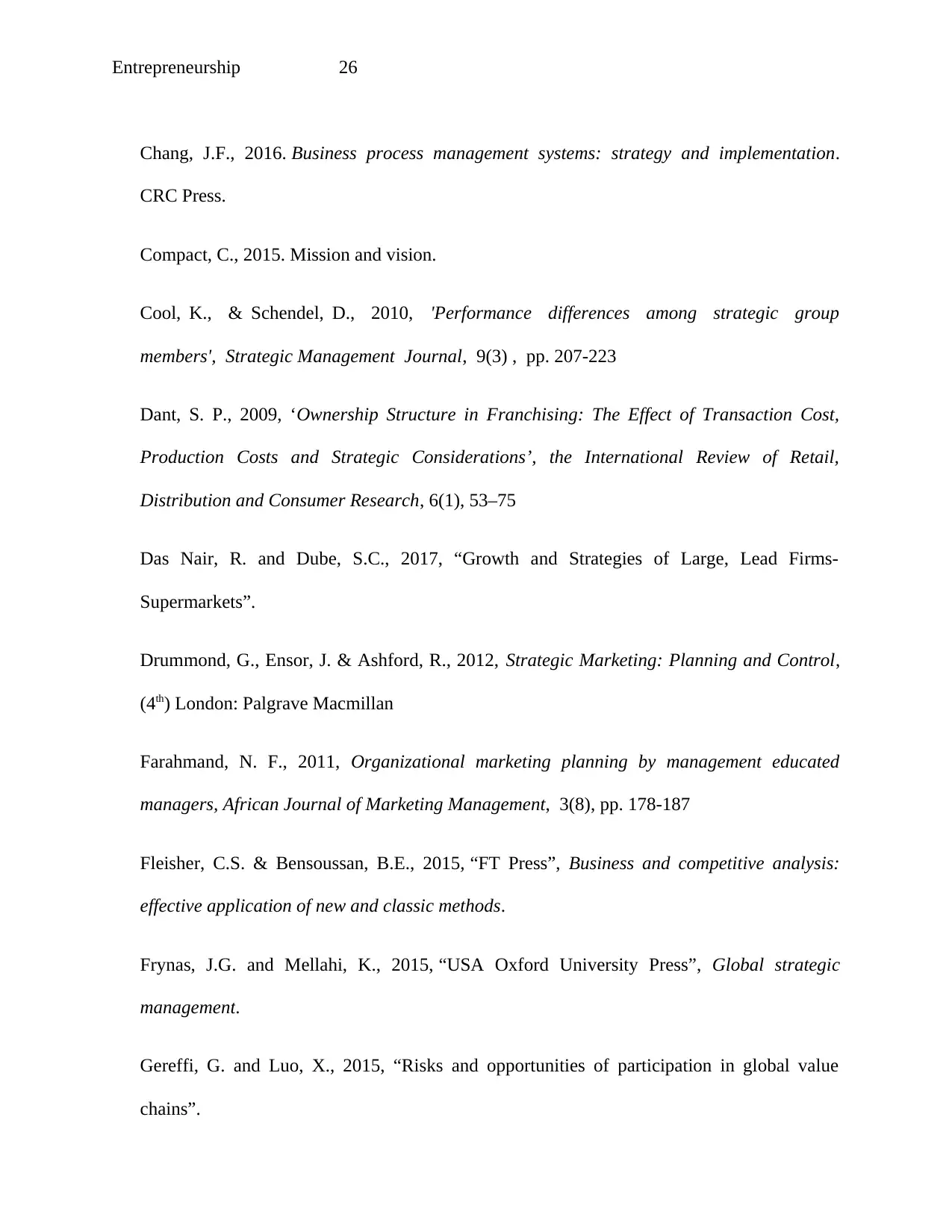
Entrepreneurship 26
Chang, J.F., 2016. Business process management systems: strategy and implementation.
CRC Press.
Compact, C., 2015. Mission and vision.
Cool, K., & Schendel, D., 2010, 'Performance differences among strategic group
members', Strategic Management Journal, 9(3) , pp. 207-223
Dant, S. P., 2009, ‘Ownership Structure in Franchising: The Effect of Transaction Cost,
Production Costs and Strategic Considerations’, the International Review of Retail,
Distribution and Consumer Research, 6(1), 53–75
Das Nair, R. and Dube, S.C., 2017, “Growth and Strategies of Large, Lead Firms-
Supermarkets”.
Drummond, G., Ensor, J. & Ashford, R., 2012, Strategic Marketing: Planning and Control,
(4th) London: Palgrave Macmillan
Farahmand, N. F., 2011, Organizational marketing planning by management educated
managers, African Journal of Marketing Management, 3(8), pp. 178-187
Fleisher, C.S. & Bensoussan, B.E., 2015, “FT Press”, Business and competitive analysis:
effective application of new and classic methods.
Frynas, J.G. and Mellahi, K., 2015, “USA Oxford University Press”, Global strategic
management.
Gereffi, G. and Luo, X., 2015, “Risks and opportunities of participation in global value
chains”.
Chang, J.F., 2016. Business process management systems: strategy and implementation.
CRC Press.
Compact, C., 2015. Mission and vision.
Cool, K., & Schendel, D., 2010, 'Performance differences among strategic group
members', Strategic Management Journal, 9(3) , pp. 207-223
Dant, S. P., 2009, ‘Ownership Structure in Franchising: The Effect of Transaction Cost,
Production Costs and Strategic Considerations’, the International Review of Retail,
Distribution and Consumer Research, 6(1), 53–75
Das Nair, R. and Dube, S.C., 2017, “Growth and Strategies of Large, Lead Firms-
Supermarkets”.
Drummond, G., Ensor, J. & Ashford, R., 2012, Strategic Marketing: Planning and Control,
(4th) London: Palgrave Macmillan
Farahmand, N. F., 2011, Organizational marketing planning by management educated
managers, African Journal of Marketing Management, 3(8), pp. 178-187
Fleisher, C.S. & Bensoussan, B.E., 2015, “FT Press”, Business and competitive analysis:
effective application of new and classic methods.
Frynas, J.G. and Mellahi, K., 2015, “USA Oxford University Press”, Global strategic
management.
Gereffi, G. and Luo, X., 2015, “Risks and opportunities of participation in global value
chains”.
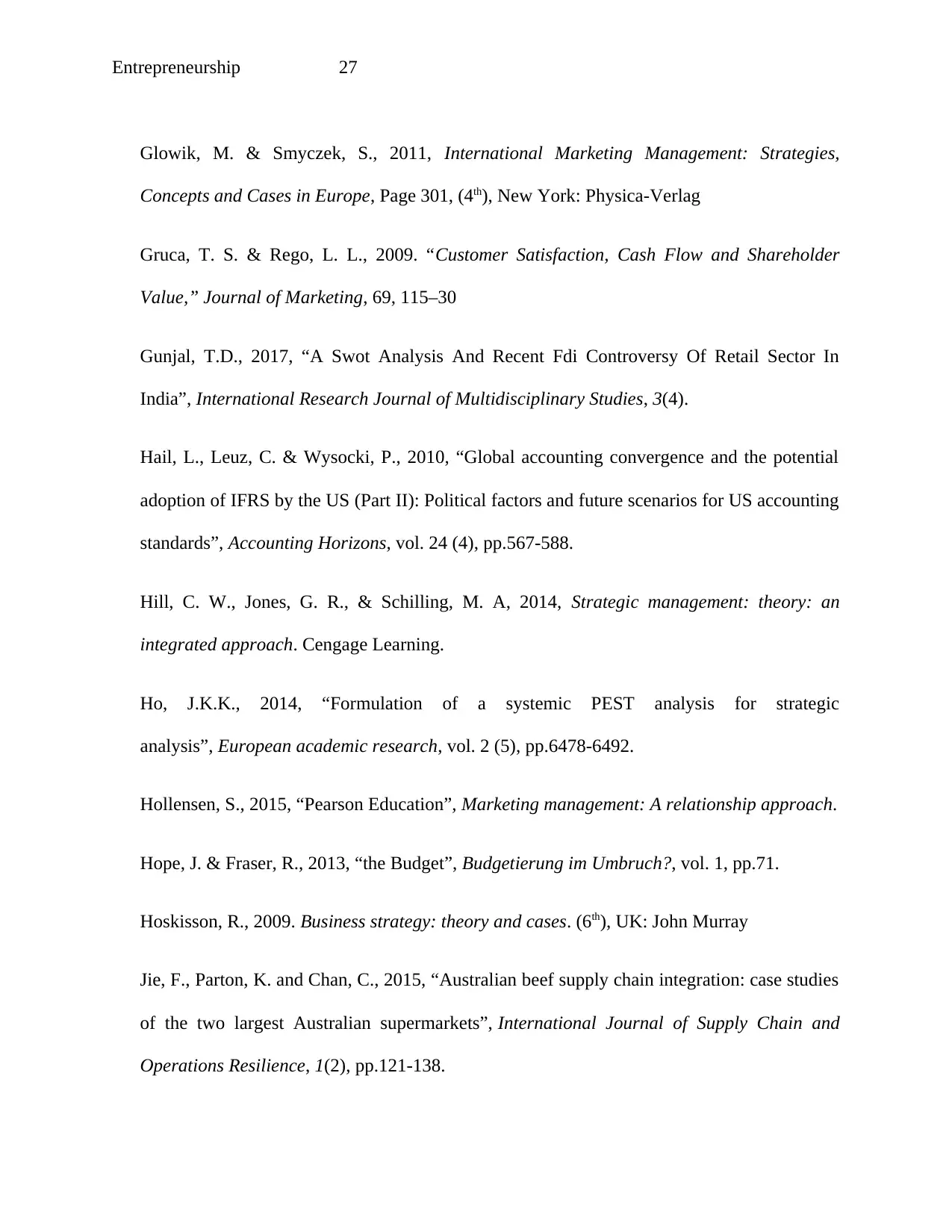
Entrepreneurship 27
Glowik, M. & Smyczek, S., 2011, International Marketing Management: Strategies,
Concepts and Cases in Europe, Page 301, (4th), New York: Physica-Verlag
Gruca, T. S. & Rego, L. L., 2009. “Customer Satisfaction, Cash Flow and Shareholder
Value,” Journal of Marketing, 69, 115–30
Gunjal, T.D., 2017, “A Swot Analysis And Recent Fdi Controversy Of Retail Sector In
India”, International Research Journal of Multidisciplinary Studies, 3(4).
Hail, L., Leuz, C. & Wysocki, P., 2010, “Global accounting convergence and the potential
adoption of IFRS by the US (Part II): Political factors and future scenarios for US accounting
standards”, Accounting Horizons, vol. 24 (4), pp.567-588.
Hill, C. W., Jones, G. R., & Schilling, M. A, 2014, Strategic management: theory: an
integrated approach. Cengage Learning.
Ho, J.K.K., 2014, “Formulation of a systemic PEST analysis for strategic
analysis”, European academic research, vol. 2 (5), pp.6478-6492.
Hollensen, S., 2015, “Pearson Education”, Marketing management: A relationship approach.
Hope, J. & Fraser, R., 2013, “the Budget”, Budgetierung im Umbruch?, vol. 1, pp.71.
Hoskisson, R., 2009. Business strategy: theory and cases. (6th), UK: John Murray
Jie, F., Parton, K. and Chan, C., 2015, “Australian beef supply chain integration: case studies
of the two largest Australian supermarkets”, International Journal of Supply Chain and
Operations Resilience, 1(2), pp.121-138.
Glowik, M. & Smyczek, S., 2011, International Marketing Management: Strategies,
Concepts and Cases in Europe, Page 301, (4th), New York: Physica-Verlag
Gruca, T. S. & Rego, L. L., 2009. “Customer Satisfaction, Cash Flow and Shareholder
Value,” Journal of Marketing, 69, 115–30
Gunjal, T.D., 2017, “A Swot Analysis And Recent Fdi Controversy Of Retail Sector In
India”, International Research Journal of Multidisciplinary Studies, 3(4).
Hail, L., Leuz, C. & Wysocki, P., 2010, “Global accounting convergence and the potential
adoption of IFRS by the US (Part II): Political factors and future scenarios for US accounting
standards”, Accounting Horizons, vol. 24 (4), pp.567-588.
Hill, C. W., Jones, G. R., & Schilling, M. A, 2014, Strategic management: theory: an
integrated approach. Cengage Learning.
Ho, J.K.K., 2014, “Formulation of a systemic PEST analysis for strategic
analysis”, European academic research, vol. 2 (5), pp.6478-6492.
Hollensen, S., 2015, “Pearson Education”, Marketing management: A relationship approach.
Hope, J. & Fraser, R., 2013, “the Budget”, Budgetierung im Umbruch?, vol. 1, pp.71.
Hoskisson, R., 2009. Business strategy: theory and cases. (6th), UK: John Murray
Jie, F., Parton, K. and Chan, C., 2015, “Australian beef supply chain integration: case studies
of the two largest Australian supermarkets”, International Journal of Supply Chain and
Operations Resilience, 1(2), pp.121-138.
Secure Best Marks with AI Grader
Need help grading? Try our AI Grader for instant feedback on your assignments.
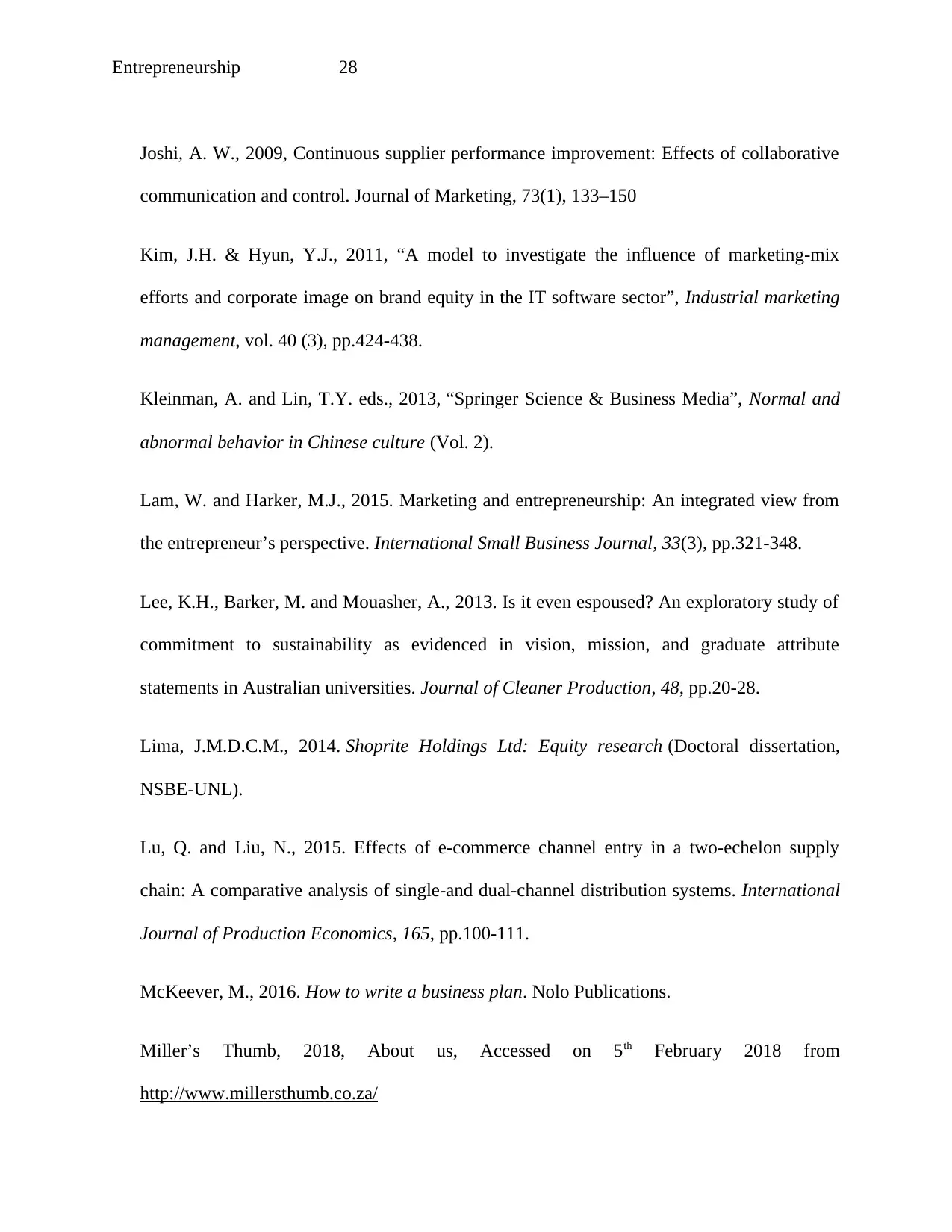
Entrepreneurship 28
Joshi, A. W., 2009, Continuous supplier performance improvement: Effects of collaborative
communication and control. Journal of Marketing, 73(1), 133–150
Kim, J.H. & Hyun, Y.J., 2011, “A model to investigate the influence of marketing-mix
efforts and corporate image on brand equity in the IT software sector”, Industrial marketing
management, vol. 40 (3), pp.424-438.
Kleinman, A. and Lin, T.Y. eds., 2013, “Springer Science & Business Media”, Normal and
abnormal behavior in Chinese culture (Vol. 2).
Lam, W. and Harker, M.J., 2015. Marketing and entrepreneurship: An integrated view from
the entrepreneur’s perspective. International Small Business Journal, 33(3), pp.321-348.
Lee, K.H., Barker, M. and Mouasher, A., 2013. Is it even espoused? An exploratory study of
commitment to sustainability as evidenced in vision, mission, and graduate attribute
statements in Australian universities. Journal of Cleaner Production, 48, pp.20-28.
Lima, J.M.D.C.M., 2014. Shoprite Holdings Ltd: Equity research (Doctoral dissertation,
NSBE-UNL).
Lu, Q. and Liu, N., 2015. Effects of e-commerce channel entry in a two-echelon supply
chain: A comparative analysis of single-and dual-channel distribution systems. International
Journal of Production Economics, 165, pp.100-111.
McKeever, M., 2016. How to write a business plan. Nolo Publications.
Miller’s Thumb, 2018, About us, Accessed on 5th February 2018 from
http://www.millersthumb.co.za/
Joshi, A. W., 2009, Continuous supplier performance improvement: Effects of collaborative
communication and control. Journal of Marketing, 73(1), 133–150
Kim, J.H. & Hyun, Y.J., 2011, “A model to investigate the influence of marketing-mix
efforts and corporate image on brand equity in the IT software sector”, Industrial marketing
management, vol. 40 (3), pp.424-438.
Kleinman, A. and Lin, T.Y. eds., 2013, “Springer Science & Business Media”, Normal and
abnormal behavior in Chinese culture (Vol. 2).
Lam, W. and Harker, M.J., 2015. Marketing and entrepreneurship: An integrated view from
the entrepreneur’s perspective. International Small Business Journal, 33(3), pp.321-348.
Lee, K.H., Barker, M. and Mouasher, A., 2013. Is it even espoused? An exploratory study of
commitment to sustainability as evidenced in vision, mission, and graduate attribute
statements in Australian universities. Journal of Cleaner Production, 48, pp.20-28.
Lima, J.M.D.C.M., 2014. Shoprite Holdings Ltd: Equity research (Doctoral dissertation,
NSBE-UNL).
Lu, Q. and Liu, N., 2015. Effects of e-commerce channel entry in a two-echelon supply
chain: A comparative analysis of single-and dual-channel distribution systems. International
Journal of Production Economics, 165, pp.100-111.
McKeever, M., 2016. How to write a business plan. Nolo Publications.
Miller’s Thumb, 2018, About us, Accessed on 5th February 2018 from
http://www.millersthumb.co.za/
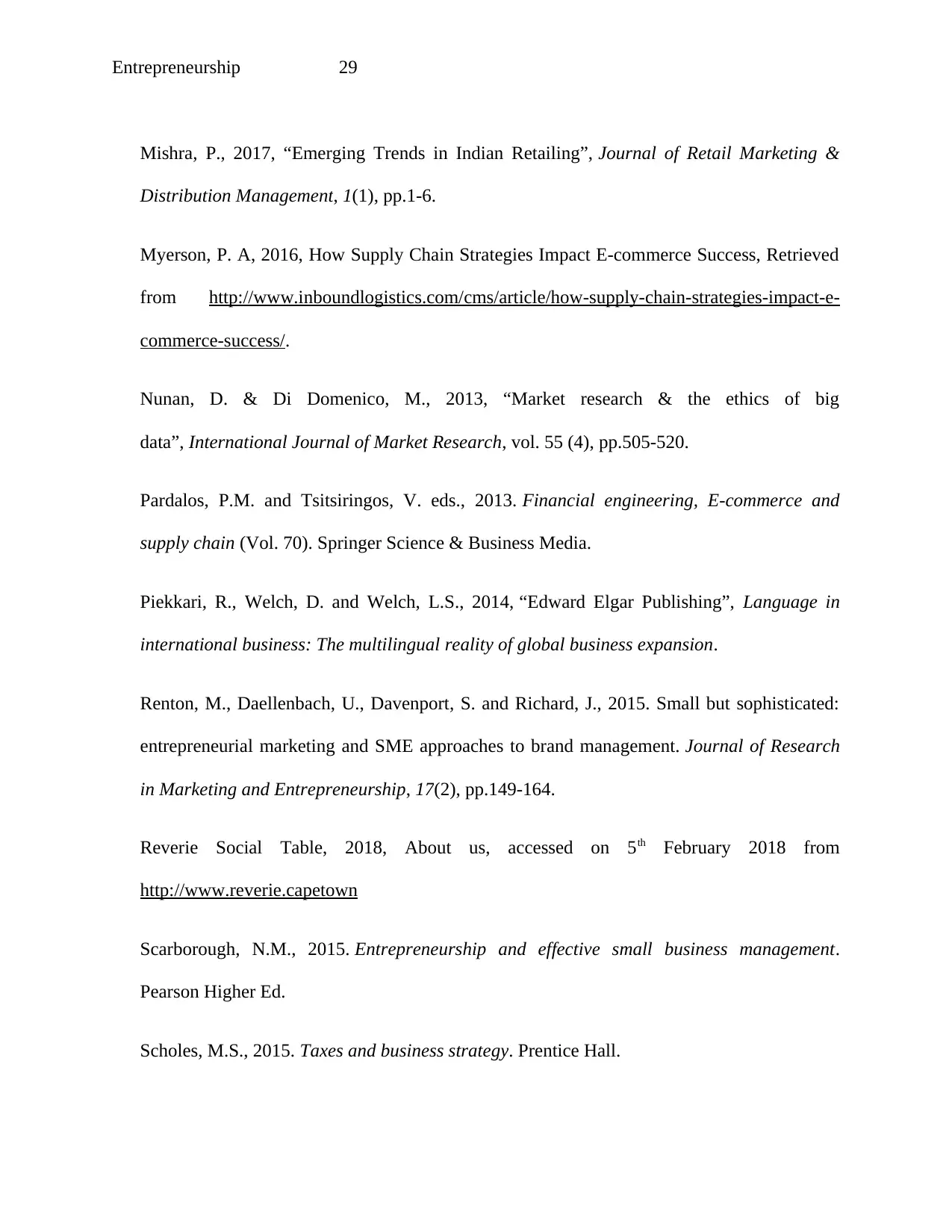
Entrepreneurship 29
Mishra, P., 2017, “Emerging Trends in Indian Retailing”, Journal of Retail Marketing &
Distribution Management, 1(1), pp.1-6.
Myerson, P. A, 2016, How Supply Chain Strategies Impact E-commerce Success, Retrieved
from http://www.inboundlogistics.com/cms/article/how-supply-chain-strategies-impact-e-
commerce-success/.
Nunan, D. & Di Domenico, M., 2013, “Market research & the ethics of big
data”, International Journal of Market Research, vol. 55 (4), pp.505-520.
Pardalos, P.M. and Tsitsiringos, V. eds., 2013. Financial engineering, E-commerce and
supply chain (Vol. 70). Springer Science & Business Media.
Piekkari, R., Welch, D. and Welch, L.S., 2014, “Edward Elgar Publishing”, Language in
international business: The multilingual reality of global business expansion.
Renton, M., Daellenbach, U., Davenport, S. and Richard, J., 2015. Small but sophisticated:
entrepreneurial marketing and SME approaches to brand management. Journal of Research
in Marketing and Entrepreneurship, 17(2), pp.149-164.
Reverie Social Table, 2018, About us, accessed on 5th February 2018 from
http://www.reverie.capetown
Scarborough, N.M., 2015. Entrepreneurship and effective small business management.
Pearson Higher Ed.
Scholes, M.S., 2015. Taxes and business strategy. Prentice Hall.
Mishra, P., 2017, “Emerging Trends in Indian Retailing”, Journal of Retail Marketing &
Distribution Management, 1(1), pp.1-6.
Myerson, P. A, 2016, How Supply Chain Strategies Impact E-commerce Success, Retrieved
from http://www.inboundlogistics.com/cms/article/how-supply-chain-strategies-impact-e-
commerce-success/.
Nunan, D. & Di Domenico, M., 2013, “Market research & the ethics of big
data”, International Journal of Market Research, vol. 55 (4), pp.505-520.
Pardalos, P.M. and Tsitsiringos, V. eds., 2013. Financial engineering, E-commerce and
supply chain (Vol. 70). Springer Science & Business Media.
Piekkari, R., Welch, D. and Welch, L.S., 2014, “Edward Elgar Publishing”, Language in
international business: The multilingual reality of global business expansion.
Renton, M., Daellenbach, U., Davenport, S. and Richard, J., 2015. Small but sophisticated:
entrepreneurial marketing and SME approaches to brand management. Journal of Research
in Marketing and Entrepreneurship, 17(2), pp.149-164.
Reverie Social Table, 2018, About us, accessed on 5th February 2018 from
http://www.reverie.capetown
Scarborough, N.M., 2015. Entrepreneurship and effective small business management.
Pearson Higher Ed.
Scholes, M.S., 2015. Taxes and business strategy. Prentice Hall.
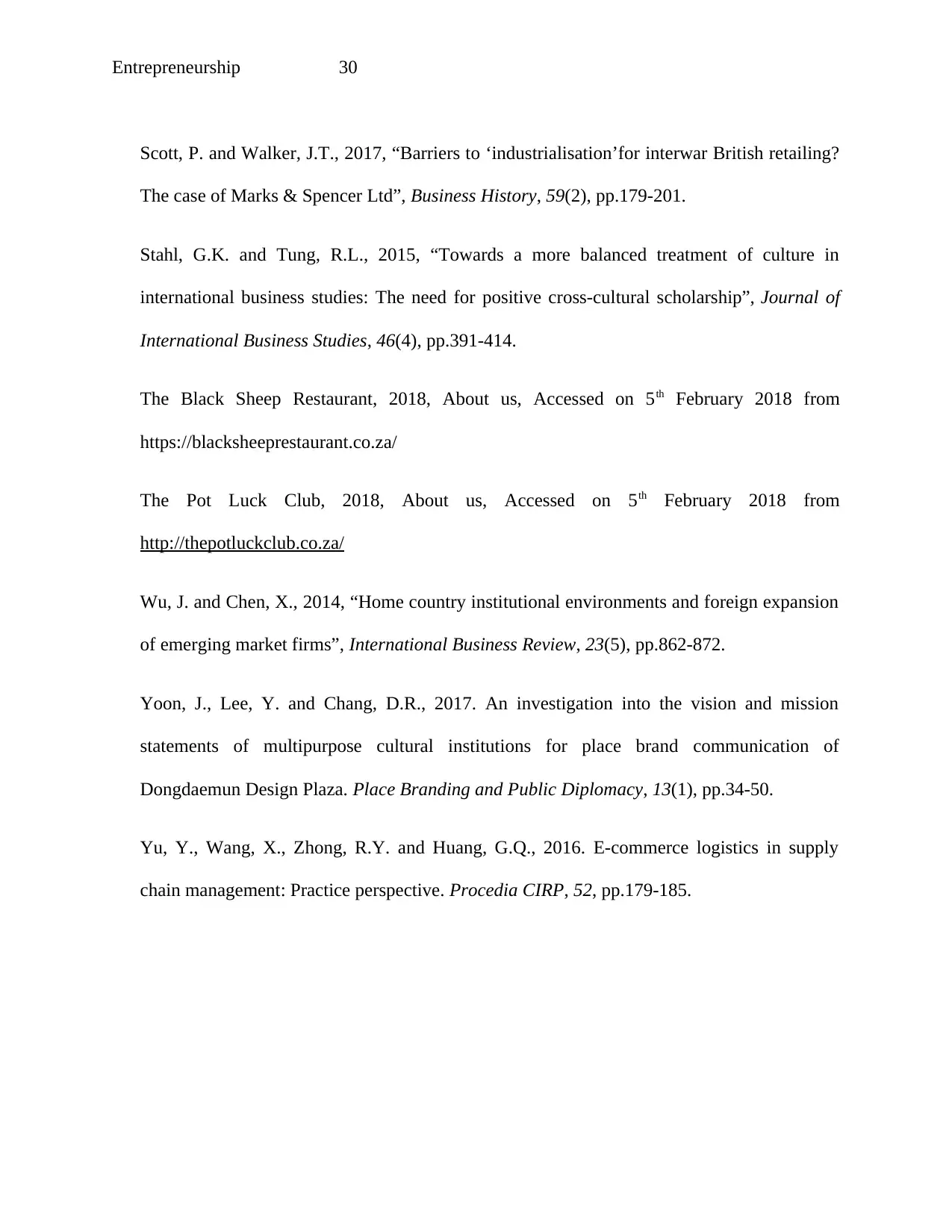
Entrepreneurship 30
Scott, P. and Walker, J.T., 2017, “Barriers to ‘industrialisation’for interwar British retailing?
The case of Marks & Spencer Ltd”, Business History, 59(2), pp.179-201.
Stahl, G.K. and Tung, R.L., 2015, “Towards a more balanced treatment of culture in
international business studies: The need for positive cross-cultural scholarship”, Journal of
International Business Studies, 46(4), pp.391-414.
The Black Sheep Restaurant, 2018, About us, Accessed on 5th February 2018 from
https://blacksheeprestaurant.co.za/
The Pot Luck Club, 2018, About us, Accessed on 5th February 2018 from
http://thepotluckclub.co.za/
Wu, J. and Chen, X., 2014, “Home country institutional environments and foreign expansion
of emerging market firms”, International Business Review, 23(5), pp.862-872.
Yoon, J., Lee, Y. and Chang, D.R., 2017. An investigation into the vision and mission
statements of multipurpose cultural institutions for place brand communication of
Dongdaemun Design Plaza. Place Branding and Public Diplomacy, 13(1), pp.34-50.
Yu, Y., Wang, X., Zhong, R.Y. and Huang, G.Q., 2016. E-commerce logistics in supply
chain management: Practice perspective. Procedia CIRP, 52, pp.179-185.
Scott, P. and Walker, J.T., 2017, “Barriers to ‘industrialisation’for interwar British retailing?
The case of Marks & Spencer Ltd”, Business History, 59(2), pp.179-201.
Stahl, G.K. and Tung, R.L., 2015, “Towards a more balanced treatment of culture in
international business studies: The need for positive cross-cultural scholarship”, Journal of
International Business Studies, 46(4), pp.391-414.
The Black Sheep Restaurant, 2018, About us, Accessed on 5th February 2018 from
https://blacksheeprestaurant.co.za/
The Pot Luck Club, 2018, About us, Accessed on 5th February 2018 from
http://thepotluckclub.co.za/
Wu, J. and Chen, X., 2014, “Home country institutional environments and foreign expansion
of emerging market firms”, International Business Review, 23(5), pp.862-872.
Yoon, J., Lee, Y. and Chang, D.R., 2017. An investigation into the vision and mission
statements of multipurpose cultural institutions for place brand communication of
Dongdaemun Design Plaza. Place Branding and Public Diplomacy, 13(1), pp.34-50.
Yu, Y., Wang, X., Zhong, R.Y. and Huang, G.Q., 2016. E-commerce logistics in supply
chain management: Practice perspective. Procedia CIRP, 52, pp.179-185.
1 out of 31
Your All-in-One AI-Powered Toolkit for Academic Success.
+13062052269
info@desklib.com
Available 24*7 on WhatsApp / Email
![[object Object]](/_next/static/media/star-bottom.7253800d.svg)
Unlock your academic potential
© 2024 | Zucol Services PVT LTD | All rights reserved.




